#San Japan 2015
Explore tagged Tumblr posts
Text
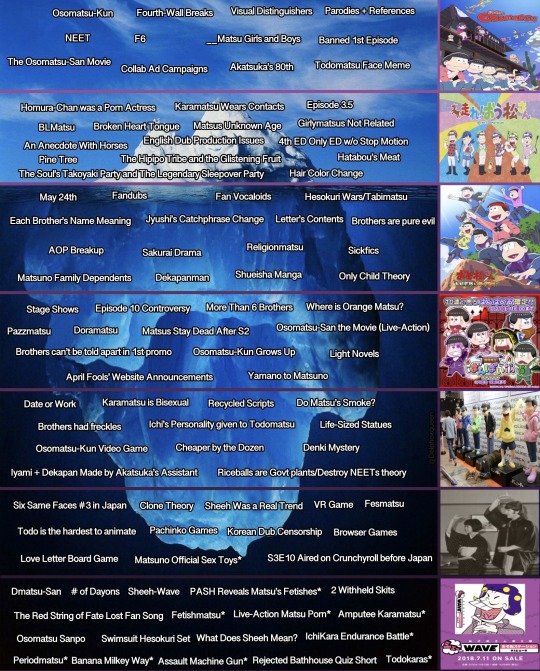
The Osomatsu-San Iceberg 2.0!
(Click More For Full Explanation)
*- Take Caution When Researching
Tier 1-
Osomatsu-Kun- A Comedy Manga by Fujio Akatsuka which ran from 1962 to 1969 which followed a group of sextuplet (a multiple birth of six children) brothers. It was later adapted into two anime, one by Studio Zero in 1966 and another by Studio Pierrot in 1988 as well as spin-off by Studio Pierrot in 2015 titled “Osomatsu-San” which follows the sextuplets in their 20-somethings as NEETS.
Fourth-Wall Breaks- Osomatsu-San has multiple moments where the characters will break the fourth wall, such as in the first episode where the characters try to be a “proper anime”, or worship Fujio Akatsuka like a god.
Visual Distinguishers- The Matsuno Brothers have multiple visual distinguishers so the audience can more easily tell the brothers apart. Examples include: Signature Color, Hairstyles, and Facial Expressions. The brothers were given different colors supposedly because the character designer couldn’t tell the difference between them.
Parodies + References- The anime makes dozens of parodies and references to other anime/popular media such as Attack on Titan, Saw, Demon Slayer, Naruto, and Sailor Moon. The anime’s extreme popularity in Japan also led to other anime to parody and reference Osomatsu-San including The Disastrous Life of Saiki K, Love Rice, and JoJo’s Bizarre Adventure. Osomatsu-San has too many references to other anime and there’s too many references to Osomatsu-San from other media, so I just included it as one entry.
NEET- A common acronym in Japan which stands for Not in Education, Employment, or Training, but also includes anyone who is not engaged in housework, unemployed, not seeking work, and not in any school or work-related training.
F6- The F6 are the idealized version of the Matsuno brothers that parody pretty-boy anime. The “F” in F6 stands for Fujio, as in Fujio Akatsuka, the creator of the original manga. In the first episode, their first appearance, Ichimatsu transforms into a hybrid stylization of the 2015 anime and the 1966 anime, but in the season finale they are seen alongside the Matsuno brothers, implying they are separate characters.
___Matsu Boys and Girls- The fan term for each of the six brothers, based on Karamatsu’s line calling his fans his “Karamatsu girls and boys”.
Banned 1st Episode- The 1st episode of the anime was banned in Japan due to copyright law, as Japan has no clause for parody and has a more strict interpretation of fair use. It was never confirmed which company filed a copyright infringement against Osomatsu-San, but there is a theory that the Attack on Titan parody was the main culprit. The episode has still not been released on physical media and all streaming services do not carry the first episode, instead beginning the series on the second episode.
The Osomatsu-San Movie- Released on March 15th 2019, the movie follows the brothers traveling back in time to meet their high school selves and to resolve one of the brothers’ biggest regrets.
Collab Ad Campaigns- Osomatsu-San has collaborated with dozens of other brands on merchandise/advertisement campaigns. Many of these collaborations have created special events and merchandise for Osomatsu-San. Examples include: Ministop, Sweets Paradise, Dohtonbori Okonomiyaki, and Sanrio.
Akatsuka’s 80th- Osomatsu-San was created in honor of Fujio Akatsuka’s 80th Birthday and death, having died at 72 in 2008.
Todomatsu Face Meme- In the episode “Todomatsu and the 5 Demons” Todomatsu makes a face at his brothers for talking to the Sutabaa baristas, which has become a meme that has even spread outside the Osomatsu-San fandom.
Tier 2-
Homura-Chan is a Porn Actress- Although nothing is stated outright, it is heavily implied in her first episode appearance that she is a porn actress as Osomatsu finds a porn movie and seems surprised by the cover before going on to have a conversation with Jyushimatsu which Jyushi ultimately avoids.
Karamatsu Wears Contacts- A fun fact that few in the fandom seem to remember is that Karamatsu wears contact lenses. Although he (and all the Matsuno Brothers) have brown eyes, he wears brown contacts, but the presumed reason he wears contacts is because circle contacts (mainly worn by cosplayers and Japanese teen girls) make eyes look bigger and cuter- which is why Osomatsu insults him for wearing them.
Episode 3.5- Also titled “Episode 3.5: Virgin Heroes”, an episode was created to be put on home media releases to replace the 1st episode due to the ban. It is chronologically after Episode 3 but before Episode 4 and has two segments. The first segment features the F6 in a parody commercial, with the second focusing on Choromatsu seeing a group of college kids having a barbecue and being visited by the Cherry Boys (the other five Matsuno brothers in Power-Ranger parody outfits)
BLMatsu- A fandom term for incest ships involving the Matsuno brothers romantically or sexually. BL stands for Boys Love, which is a popular anime and manga term for gay male pairings typically aimed at women. Common ships include OsoChoro and KaraIchi.
Broken Heart Tongue- A small detail in the series is that whenever Jyushimatsu is depicted smiling, his tongue is in the shape of a heart, but in the episode “Jyushimatsu’s Girlfriend” when Jyushimatsu is crying at Chibita’s Oden stand, his tongue is a broken heart.
Matsus Unknown Age- The brothers’ age has never been specified in the Osomatsu-San anime. They are said to “not be older than 24 or 25” and that their parents have been married 24 years and they were born soon after, so they have been assumed to be around 24 but it has never been confirmed.
Girlymatsus not Related- A common misconception in the fandom is that the Girlymatsus are sisters, or the earlier fan theory in Season 1 that they are the Matsuno brothers in drag- but the Girlymatsus were later confirmed just to be friends.
An Anecdote With Horses- An exclusive episode made in collaboration with the Japan Racing Association (JRA) which aired on December 16th, 2016 which featured skits of the Matsuno brothers racing horses.
English Dub Production Issues- After Viz Media acquired the rights to Osomatsu-San, it came out in September 2020 that the English Dub of Osomatsu-San was delayed to be reworked as well as having to replace Christopher Niosi (Choromatsu’s original VA) with Sean Chiplock, due to abuse allegations which Christopher later confessed to.
4th ED is the only ED without stop-motion- While the majority of the Osomatsu-San ending themes feature stop-motion using a variety of items such as toys, clothing, and food; the 4th ending (the second ending of the second season) uses slow-motion footage of paint being dumped onto busts of the Matsuno brothers.
Pine Tree- The kanji for “Matsu” translates to Pine Tree, which is why the pine tree symbol is so frequent in the show’s iconography, such as in the title and on the brothers’ sweaters.
The Hipipo Tribe and The Glistening Fruit- The first of two movies released to celebrate the sixth anniversary of the anime, which features the brothers journeying to find a fruit which grants wishes before encountering the Hipipo Tribe.
Hatabou’s Meat- In the episode “Tell Us, Hatabou”, Hatabou sells meat out of a variety of vendors, but when the brothers ask what kind of meat it is he refuses to answer. Earlier in the episode his employees try to boot him from the company, which leads to his new business venture, implying that the meat is of his former employees though it is never stated outright within the show.
The Soul’s Takoyaki Party and The Legendary Sleepover Party- The second of the two movies released to celebrate the sixth anniversary of the anime, which features the brothers hosting a takoyaki (grilled dough balls with octopus inside with a variety of toppings) party which turns into a sleepover.
Hair Color Change- In the original series Osomatsu-Kun, both the 60s and 80s, the brothers had brown hair but in Osomatsu-San they are depicted with black hair.
Tier 3-
May 24th- The Birthday of the Matsuno Brothers.
Fandubs- Due to the long development time and many delays of the official English Dub, there are multiple fandom dubs of the anime.
Fan Vocaloids- The Osomatsu-San fandom has many popular fan vocaloid covers, some of the most well-known including Matryoshka, Normie Eradication Committee, Rolling Girl, and LOVE 1000%.
Hesokuri Wars/Tabimatsu- Also known as “Osomatsu-San Hesokuri Wars -Battle of the NEETS-“ is tower-defense style strategy mobile game that was released in Japan in 2016 and later being released in English in 2017, before being shut down on October 2nd of 2022 to make way for Tabimatsu. Players would choose a team of 10 characters to fight through stages, with dozens of exclusive events and character variations being released. Many popular AUs in the fandom were inspired by sets released for Hesokuri Wars.
Each Brother’s Name Meaning- Osomatsu translates to lame, or Osoi which means slow- referring to him being the most “basic” of the brothers and lazy. Kara can mean emptiness, referring to his narcissism and chasing his brothers’ approval. Choroi translates to simple, referring to his more average personality. Ichimatsumuyo means checkered pattern (along the lines of a Go board). Jyushimatsu translates to society finch, which are known to be kind like Jyushi. Todomatsu meaning Manchurian fir or “finally”, as “finally” was his catchphrase in the original 60s anime.
Jyushimatsu’s Catchphrase Change- In the first season Jyushimatsu’s main catchphrase was “Muscle Muscle, Hustle Hustle” but in season two and onwards, it was changed more to “Booeh.” There wasn’t any explanation given by the show staff as to why it was changed.
Letter’s Contents- The entire letter Choromatsu had written in “Letter” was never revealed, with only one or two lines spoken by Choromatsu at the beginning of the skit describing what he’d written before later modifying it, leading fans to speculate exactly what was written.
Brothers are pure evil- At the end of the episode “Godmatsu”, in order to defeat Godmatsu the brothers combine their darkness to create Akamatsu. Once Godmatsu is defeated, they absorb only Akamatsu back into themselves, therefore only being made of their evil self. This possibly explains their more violent nature after this point in the series.
AOP Breakup- AOP is an idol group that formed in 2012 under the agency Nikkei Entertainment. The group created multiple songs for the anime, including the theme songs “Zenryoku Batankyu wa Yoiko Dake”, “Hanamaru Pippi wa Yoiko Dake”, “Maboroshi Wink”, and “nice to NEET You!” On December 14th, 2020 the band stated they would be ceasing activities before disbanding in 2021.
Sakurai Drama- Takahiro Sakurai is the original VA for Osomatsu who admitted in 2022 to having cheated on his wife for 10 years, planning to eventually marry his affair partner. Due to this scandal, Osomatsu-San content has been delayed for the past two years.
Religionmatsu- A popular AU which depicts the Matsu brothers as gods, devils, angels, and clergymen. One of the few AUs which was created by the fandom and not inspired by a Hesokuri Wars set.
Sickfics- A fanfiction genre in which one character cares for another who is sick. These fanfics are particularly popular in the Osomatsu-San fandom because of the episode “We Caught a Cold” in which all of the brothers catch a cold and each have a moment to care for the others.
Matsuno Family Dependents- A “wallpaper simulator” type mobile game where the player collects variants of the Matsu brothers and raises them.
Dekapanman- A Parody of Anpanman in which Dekapan dresses up as a hero that gives items from pants to children which was significantly censored due to the controversy and copyright infringement caused by the parody.
Shueisha Manga- Beginning in 2016, a manga series was released alongside the anime. Published by Shueisha in the magazine You from 2016 to 2018 then Cookie from 2018 to 2020 with 10 volumes of stories not featured in the anime.
Only Child Theory- Theory that states that Osomatsu is an Only child with a personality disorder that causes him to develop different personalities that are “his brothers”. As the first known sextuplets to have been born and all survive were born in 1974, many years after the original 60s anime aired. The skit “Sanematsu” is often used as proof for this theory.
Tier 4-
Stage Shows- “Osomatsu-San on Stage: SIX MEN’S SHOW TIME” is a musical adaptation of the original anime, with three seasons matching the anime and having been released on home media.
Episode 10 Controversy- There are some reports of Episode 10 causing controversy upon release for having characters transition to women for personal gain. (Though I will admit, in my research I could not find any comments/posts accusing the show of being transphobic. The only slight criticism I could find was of the ending being too harsh towards Chibita and Iyami’s actions and the episode’s pacing being too slow. I am not claiming that the controversy does or does not exist, or that the episode is or isn’t offensive, I just could not find any evidence in my research of people taking offense to it.)
More Than 6 Brothers- Theory that there are more than 6 brothers as in some scenes in the anime and some promotional material it appears that there’s more than 6 brothers. Though there are episodes in the anime in which another brother is accepted into the group or created such as Godmatsu or Akamatsu.
Where is Orange Matsu?- The brothers all fit the primary (Red- Osomatsu, Yellow- Jyushimatsu, Blue- Karamatsu) and secondary (Green- Choromatsu, Purple- Ichimatsu) colors with the exception of orange as Todomatsu’s main color is pink. This has led some to theorize that there is a secret orange brother. The show creators stated that they made Todomatsu’s color pink to make his style more feminine and youthful, as well as to show that he’s intentionally trying to not fit in with his brothers by not following the same pattern.
Pazzmatsu- AKA Puzzlematsu is a match-3-tiles puzzle mobile game released in Japan in 2016 which continued until April 2018 when it was rebooted as “New Pazzmatsu”.
Doramatsu- A series of audio drama CDs that include unique stories that did not appear in the anime.
Matsus Stay Dead After S2- In the finale of Season 2, the brothers die from a plane crash and are sent to hell for their numerous misdeeds. This theory posits that the brothers stayed dead after the end of season two and that season three is their personal hell. This is a joke theory to explain season three’s shift in focus.
Osomatsu-San the Live-Action Movie- A Live-Action movie with a unique story based on Osomatsu-San with members of the J-Pop group Snow Man playing the Matsu brothers.
Brothers can’t be told apart in 1st promo- In the first promotional image released for the anime, the brothers’ personalities and visual distinguishers hadn’t been ironed out yet so long-time fans of the series noticed that it’s near impossible to distinguish which brother is which in the image. The only brother that is able to be identified is the center brother holding Karamatsu’s signature glasses.
Osomatsu-Kun Grows Up- Technically Osomatsu-San is an alternate universe to the original Osomatsu-Kun series canon, as in 1993 a beer ad was published showing what the Matsu brothers became when they reached adulthood. Osomatsu becomes a salaryman, Karamatsu marries a grocer’s daughter and helps with the family business, Choromatsu becomes a policeman, Ichimatsu marries and becomes a CEO, Jyushimatsu becomes a doctor, and Todomatsu works in a fish market.
Light Novels- Osomatsu-San has spawned a handful of Light Novels and short stories with plots not included in the anime. Examples include: Osomatsu-San the Beforematsu and Aftermatsu, VS Kochikame, and Shut Up Osomatsu.
April Fools- To celebrate April Fools, Osomatsu-San has released multiple fake announcements and fake Tabimatsu sets. This includes the 2015 announcement that the series would be releasing a new Osomatsu-Kun project, the 2017 announcement that a live-action adaptation starring the Byplayers would replace the anime, and the 2019 Tabimatsu set with a Irasutoya art style.
Yamano to Matsuno- The last name of the family was originally Yamano but was changed to Matsuno last minute as Yamano was considered a more “generic” last name.
Tier 5-
Date or Work- Also known as “Osomatsu-San the Game” is an adventure game released in Japan in 2017 for the PSVita. The story has you play as a heroine who gets calls and texts from the brothers asking for advice on their quest to get a job.
Karamatsu is Bisexual- In the first Osomatsu-San movie Karamatsu says “Sorry to keep you waiting, Karamatsu girls and boys!” Also in a drama CD Karamatsu reads off a love poem that he wrote to a male convenience store worker named Kumada Youji. It’s still debated whether the drama CD is canon to the anime and if the line in the movie was just referring to his fans in a non-romantic or sexual sense.
Recycled Scripts- Some of the episodes such as “Iyami, Alone in the Wind”, “ESP Kitty”, and ”The Life of Chibita’s Flower” were based off of chapters of Osomatsu-Kun modified to fit the series. Some skits from Season 3 were also based off of Doramatsu tracks.
Do Matsu’s Smoke?- A topic of debate in the Western fandom, Karamatsu is shown to smoke in multiple episodes and Osomatsu has been shown to be surrounded by cigarette boxes previously but it hasn’t been stated whether the other four brothers smoke.
Brothers had freckles- In the original Akatsuka designs for the brothers, they were designed to have freckles on their cheeks as well as other different facial features. These were changed to make the faces look more cute and easier to draw.
Ichi’s Personality given to Todomatsu- Ichimatsu’s Personality was going to be more snarky and rude than his current more doom and gloom. His characterization was instead given to Todomatsu by Miyu Irino’s suggestion, thinking that the youngest brother being catty would be funnier.
Life-Sized Statues- For the 2016 Summer Wonder Festival, the company Figurex 3D printed life-size statues of the six brothers, with smaller versions of the figures being sold at the event as well. While some have reappeared at Osomatsu-San events, such as the Ichimatsu figure, some have not been seen since their original showcase; this has led fans to search for the statues current locations. There is a link to buy one of the statues from one of the Japanese websites that first reported the event, but the link is now dead and leads to an error page.
Osomatsu-Kun Video Game- AKA “Osomatsu-Kun: Nonsense Theater” is a platforming video game released for the Sega Mega Drive in 1988 based on the original Osomatsu-Kun manga to promote the upcoming anime. The game only had a total of three levels with confusing level design and bad controls that caused it to gain an infamous reputation. It has recently gained a cult following as a kusoge (a Japanese video game that is celebrated for its awful quality.)
Cheaper by the Dozen- The manga was originally loosely based on the TV Show “Cheaper By the Dozen” (an American film from 1950 about a couple and their 12 children) with there being 12 children, but Akatsuka found it too hard to fit 12 characters in a single panel so he decided to cut the amount in half. Eventually changing it to be identical sextuplet brothers.
Denki Mystery- A popular AU that started as a Hesokuri Wars set. As opposed to other Hesokuri Wars sets, Denki Mystery had an entire storyline based on mystery novels, David Lynch films, and Japanese horror.
Iyami + Dekapan Made By Akatsuka’s Assistant- Both the characters Iyami and Dekapan were created by Fujio Akatsuka’s Assistant and later added to the manga.
Rice balls are Govt plants/Destroy NEETS Theory- Theory that the Riceballs were created by the government to reform NEETs to be functioning members of society.
Tier 6-
Six Same Faces #3 Song in Japan- On the week of December 28th, 2015 the song SIX SAME FACES ~今夜は最高!!!!!!~ (the first ending song of the first season) reached #3 on the Billboard Hot 100 in Japan, following the album’s release on December 16th, 2015.
Clone Theory- Theory that states that the brothers were cloned from Osomatsu. (I will admit I cannot find my previous evidence of this theory, if anyone does have proof of someone creating this theory or evidence for the theory please let me know.)
Sheeh Was a Real Trend- Iyami’s catchphrase/punchline used to be a cultural meme when Osomatsu-Kun was big in Japan. Famous figures to imitate Iyami include Godzilla and John Lenon from The Beatles.
VR Game- A virtual reality game collab that ran in Anime Plaza Machida and Adore’s Sunshine Store from 2017 to 2018 in which the player would hang out with the Matsu brothers in the bathhouse. It was later released theatrically as “Movies in VR!” in 2018 with “Evangelion: Another Impact”.
Fesmatsu- To celebrate each season’s release, a festival was thrown which would feature live action skits performed by the voice cast.
Todo is the hardest to animate- According to some of the animators who worked on the first season of the anime, Todomatsu was the hardest to animate of the six brothers because of his more feminine and youthful mannerisms.
Pachinko Games- Pachinko (an arcade gambling game) Games made in collaboration with Osomatsu-San, typically reusing animation from the anime though some have original animation exclusive to particular pachinko games. Examples include: Pachislot: Osomatsu-San, Pachislot: Osomatsu-San ~The Surprise~, & CR Osomatsu-San THE Drum.
Korean Dub Censorship- Due to South Korea’s strict censorship laws, Osomatsu-San was heavily censored by completely removing shots or scenes that featured characters being nude or wearing swimsuits. Some of the ridiculous censoring goes to the point where if a character is wearing a bikini, the entire screen will be cropped to only show their chin and up. Any scenes including nudity, swearing, violence, and sexual references were cut from airing or censored to hell and back (which to be fair is 99% of Osomatsu-San.)
Browser Games- Games that were available through Yahoo, some which were ported to AU SmartPass in the Osomatsu-San NEET Collection. Some examples include: Quiz Battle, Pleasing Totoko-Chan, & Osomatsu-SAN’s Black Factory.
Love Letter Board Game- A board game which players play as the brothers trying to woo Totoko-Chan.
*Matsuno Official Sex Toys- In collaboration with Kanojo Toys, a Japanese adult toy manufacturer, two dildos replicating Ichimatsu’s and Jyushimatsu’s canon lengths were released. The items were meant to be gag gifts but sold better than expected. The official website mocking Jyushimatsu’s girth and Ichimatsu’s length. “Hand massagers” of the other four brothers were also released. I hope y’all like this iceberg because now I’m being aggressively marketed at Japanese sex toys for researching everything on here.
S3E10 Aired on Crunchyroll before Japan- The tenth episode of the third season of the anime was delayed from airing as the channel was broadcasting the TV Tokyo Live 2020 U.S. Women’s Open which had previously been delayed due to rain. Though due to an error, the episode was released on time on streaming platforms early.
Tier 7-
Dmatsu-San- An internet series animated with Flash that aired on NTT DoComo to tie in with season 2 of the anime. The series includes 12 episodes, each at a minute’s length. Each episode features one of the sextuplets interacting with either Totoko or Iyami.
# of Dayons- In the episode “Let’s Get a Job” the brothers work in a factory that is revealed to be creating Dayons or clones of Dayon- as well as in the episode “Dayon Tribe” it’s shown that there’s an entire society living within Dayon’s stomach. This has led fans to question how many Dayons there are in the world of the anime, or if every appearance of Dayon is a different Dayon.
Sheeh-Wave- An internet radio series with the VA for Iyami interviewing other voice actors in character as Iyami. Having two seasons with the first airing from 2015 to 2016 and the second airing from 2017 to 2018 broadcast on Animate.TV.
*PASH Reveals Matsunos fetishes- In a magazine interview with the VAs for the Matsu brothers, each of their VAs had to guess their character’s fetish. Osomatsu- Boobs, Karamatsu- “As long as there’s love”, Choromatsu- “I won’t say” or humiliation as said in a Drama CD, Ichimatsu- Paw pads, Jyushimatsu- “Eh?”, Todomatsu- legs and bellybutton wrinkles.
2 Withheld Skits- 2 skits that were removed after the Dekapanman apology. Presumably parodies of other Japanese children’s media, but no information about what they were have been released.
The Red String of Fate Lost Fan Song- A fan vocaloid that was released on YouTube and Niconico Douga that featured a thumbnail with the sextuplets laying in a circle with a red string connecting them together. The red string wraps around Osomatsu’s finger and forms a heart in Todomatsu’s hands. The song had the brothers sing about their connection together before bursting into tears at the song’s climax. The video has been taken down since 2020 and is now lost media.
*Fetishmatsu- The part of the Osomatsu-San community that creates fetish media featuring Osomatsu-San characters. Please take caution when researching further, because I’m not messing up my search history any further.
*Live-Action Matsu Porn- Osomatsu-San being such a popular series, multiple live-action porn videos featuring the Osomatsu-San characters (mainly featuring Karamatsu & Ichimatsu). Examples include: Karamatsu Maturbates for You, IchiKara Hajimeyo!, and Ichimatsu Spanks It.
*Amputee Karamatsu- An infamous piece of fetishmatsu art that depicts Karamatsu with his legs cut off.
Osomatsu-Sanpo- A Pokemon-GO style game where players would find and catch different variations of the sextuplets through AR on their mobile device. It only ran from February to September 2017.
Swimsuit Hesokuri Set- An unreleased Hesokuri set which has the Matsu brothers wearing pretty plain-looking one-piece bathing suits. Possibly used for testing out game mechanics in updates.
What Does Sheeh Mean?- Iyami’s catchphrase which he will scream out when surprised. When asked what the phrase meant, Fujio Akatsuka never answered, leaving the phrase a mystery to this day.
*IchiKara Endurance Battle- An infamous doujinshi piss fic with Ichimatsu and Karamatsu having an “endurance battle.” Please take caution when researching further.
*Periodmatsu- An image of a Matsu brother drawn in period blood on someone’s thigh posted by the account “Periodmatsu”. It is debated whether the image was faked or real. Often confused for Period Drama Osomatsu-San, an episode from the second season of the anime.
*Banana Milky Way (Meiboku)- An infamous beastiality doujinshi with Ichimatsu and the tiger from S1E10.
*Assault Machine Gun- An infamous 2016 doujinshi by Tellmin in which the Matsu brothers are sexually assaulted and r*ped for not being able to pay their debts to Chibita.
Rejected Bathhouse Quiz Short- A rejected skit from “Christmas Osomatsu-San”. Airing only at the 2017 Spring Nationwide Invitational Screening Festival alongside clips of each Matsu brother depending on which room you entered. Now considered to be lost media.
*Todokaras- An infamous member of the fandom that scammed their fans/followers, groomed minors, promoted beastiality, abused animals, and claimed victimhood. This is just *some* of their behavior. Please take caution when researching further.
Thank you all for all of your support and patience, if you have any questions I will try to answer to the best of my ability!
#osomatsu san#mr osomatsu#ososan#osomatsu matsuno#choromatsu matsuno#jyushimatsu matsuno#mr. osomatsu#karamatsu matsuno#todomatsu matsuno#Osomatsu San iceberg#osomatsu#karamatsu#Choromatsu#ichimatsu matsuno#ichimatsu#jyushimatsu#todomatsu
807 notes
·
View notes
Text

Some sad news to share, friends - Nobuyo Oyama, the original voice of the iconic anime cat Doraemon, has passed away at the age of 90. She had retired in 2012, due to being diagnosed with dementia. Before that, she had played the role of Japan's favorite robot cat for over 25 years. Other notable roles include Kappei Jin in Zambot 3, Katsuo Isono in Sazae-san til 1970, and was the original voice of Monokuma in the Danganronpa videogames and TV series until her retirement in 2015. Many in the Japanese entertainment industry are sharing their condolences, memories, and tributes online. You can see just a small amount of the outpouring of love here.
#news#Nobuyo Oyama#doraemon#death#seiyuu#voice actor#links out#Sazae-san#Zambot 3#70s anime#80s anime#90s anime
87 notes
·
View notes
Text

DREAME ( 드림미 ) is a south korean girl group under OCTAVIA MUSIC CO., a sub-label of GLASSHOUSE INC. originally debuting in 2017 as STUPID CUPID under MIGHTY DEVIL, five-member group—CHESKA, AIMEE, TOMIE, JEANNE, and VIVA—was known for their vibrant, quirky concept as chaotic cupids. rebranded as DREAME in 2024, the group now embraces a darker, more introspective theme, portraying puppets fighting for freedom from unseen forces.

(⠀ ⋆ ⠀)⠀⠀ INDIVIDUAL PROFILES ⠀⠀!


life was hard for CHIEKO for most of her childhood years. she grew up in a low-income family of three, struggling to live and knowing about the cruelties of life before every other child her age could. her mother tried everything to make things easier for her child, but chieko can remember every night the older woman burst into tears as she struggled with bills slowly racking up on the table. her education was going downhill because the more she refused to go to school, in worry that she’ll trouble her mother even more. when she was only twelve, chieko passed an audition to be a member of AKB48 as their fifteenth member of the ninth generation. she promoted as a group member until 2014 when she announced she would be graduating from the group and moving to south korea company due to being scouted. this created a divide among her fans, with most complaining about how unfair she was to other group members and how she never belonged in akb48. despite all that, chieko moved to korea where she trained in MIGHTY DEVIL with other trainees and was supposed to debut around 2016. however, that plan failed once half the trainees of CUPID’s PROJECT left, leaving only chieko and four other members to debut in 2017 as STUPID CUPID, later rebranded as DREAME. chieko, going as CHESKA in the group, received the roles of LEADER, LEAD VOCALIST and LEAD DANCER, showing her vocals off more than when she was in akb48.
given name ⭒ ⠀⠀ yanase chieko ( 柳瀬 知恵子 )
stage name ⭒ ⠀⠀ cheska ( 체스카 )
birthday ⭒ ⠀⠀ april 6th, 1997
birthplace ⭒ ⠀⠀ sapporo, japan
ethnicity ⭒ ⠀⠀ japanese
height ⭒ ⠀⠀ 5′4″ / 162cm
positions ⭒ ⠀⠀ leader, lead vocalist, lead dancer
face claim ⭒ ⠀⠀ minatozaki sana


AMY was born in san diego as the only child of the family. when she was only five years old, her parents divorced, dividing everything they had together, as well as amy and her attention. the couple often argued about who would take care of her, often resulting in almost physical fights that the child had to watch every single time. after a long custody battle, she moved to korea with her mother, who pretty much ignored her presence in the house not even two years later. she learned how to be independent and grew up spiteful of every happy couple she came across on the street. due to her mother’s negligence over the years, a thought got into amy’s head that she would never be accepted, so she spent her time joking around, not thinking seriously about her life, which caused her to almost fail high school. eventually, she gave up on the school and decided to become an idol, thinking it would be better for her. she auditioned for MIGHTY DEVIL RECORDS in 2015, immediately being put in CUPID’s PROJECT before later re-branding to STUPID CUPID and then to DREAME. unfortunately for her, the idol life never helped her forget her past. more often than she liked, AIMEE would lock herself in her room and completely shut down her members. this continued for a good couple of years before she got enough courage to get to know her group. she debuted as the stupid cupid’s LEAD RAPPER and LEAD VOCALIST, often dabbling in both once the opportunity arises.
given name ⭒ ⠀⠀ amy huang ( 艾美黃 )
stage name ⭒ ⠀⠀ aimee ( 에이미 )
birthday ⭒ ⠀⠀ may 9th, 1998
birthplace ⭒ ⠀⠀ san diego, usa
ethnicity ⭒ ⠀⠀ taiwanese
height ⭒ ⠀⠀ 5′5″ / 165cm
positions ⭒ ⠀⠀ lead rapper, lead vocalist
face claim ⭒ ⠀⠀ yeh shuhua


DANIELLE started her career in britain as a child actress, growing up in front of blinding cameras. her older sister, DAVINA, followed in her footsteps a couple of years later as a child model, making her the second sibling out of three to become a known name in the family. while danielle’s father was a well-respected name in his own company, her mother was more of a freelance artist who had a habit of staying at home more than she needed to. over time, danielle saw less and less of her parents, who were slowly falling apart while she was busy building her acting career. because of that, danielle grew up spoiled due to not having the right people taking care of her, which quickly went into her pretty little head. it didn’t take long for the paparazzi to reveal more about her family, managing to scope out all the dirty secrets her father did in his company; fraud, bribery and scamming being only the tip of the iceberg. after her father went to prison, danielle gave up on acting and moved to south korea with the rest of her family to turn a new leaf and forget about everything left in britain. in 2014, danielle was accepted into GLASSHOUSE and mentioned by the company as their new soloist; however, that plan failed once people caught wind of her father’s despicable actions and proceeded to boycott the company again. danielle decided to move to MIGHTY DEVIL and train for three years under CUPID’s PROJECT before she was officially announced as a member of STUPID CUPID ( now DREAME ) as their MAIN VOCALIST, LEAD DANCER and FACE OF THE GROUP. while her father’s scandal is still being mentioned and the netizens send hate to her, TOMIE refuses to acknowledge it as she continues to be a part of dreame.
given name ⭒ ⠀⠀ danielle kang ( 다니엘강 )
stage name ⭒ ⠀⠀ tomie ( 토미 )
birthday ⭒ ⠀⠀ february 13th, 1999
birthplace ⭒ ⠀⠀ oxford, england
ethnicity ⭒ ⠀⠀ south korean
height ⭒ ⠀⠀ 5′6″ / 167cm
positions ⭒ ⠀⠀ main vocalist, lead dancer, face of the group
face claim ⭒ ⠀⠀ jang eunseong ( main ) & song hyemin / emma ( second )


JEANNE was born in nice, france and is an only child in the lee family; however, it never felt that way. it seemed like she was consistently surrounded by her cousins and grandma, whom she never liked. whenever her parents were too busy with work, they left her in the arms of her spiteful grandmother. jeanne grew up to be a peculiar child, antisocial and locked up in her room most days. she was taught to keep everything to herself, be quiet, and listen to what her elders say. it was hell for her until she went on a holiday to south korea, wanting to learn more about the country where her family came from. her reason for applying for the company has always been that she had nothing to lose; therefore, she did it only because it looked interesting at that moment. but somewhere deep inside her, she just wanted a reason to escape her extended family. jeanne never expected to be accepted in the company, let alone debut in STUPID CUPID ( now DREAME ) three years later as their MAIN RAPPER and LEAD DANCER. not too long after the group’s official debut, jeanne got involved in a scandal where people complained about her straightforward personality and emotionless expressions that creeped out some people. their main argument was that she should be smiling and having fun in front of the cameras and not be a broody teenager. the scandal followed her for months, and it is still being mentioned once in a while. although jeanne has said multiple times that she’s working on her personality, she can never escape her thoughts behind the scenes.
given name ⭒ ⠀⠀ jeanne lee ( 제안이 )
stage name ⭒ ⠀⠀ jeanne ( 제안 )
birthday ⭒ ⠀⠀ february 24th, 1999
birthplace ⭒ ⠀⠀ nice, france
ethnicity ⭒ ⠀⠀ south korean
height ⭒ ⠀⠀ 5′5″ / 165cm
positions ⭒ ⠀⠀ main rapper, lead dancer
face claim ⭒ ⠀⠀ lee gahyun


CHAEWON was raised in a strict christian family as a single child. everything she knew was learned by watching her parents and following in their footsteps. every saturday, chaewon would be tutored to get better in her class, while every sunday was saved for the church her parents dragged her to. not long after, her mother forced her to go to ballet classes, mostly because she was a famous ballerina. not wanting to disappoint her mother, little chaewon forced herself to wake up every weekend at five in the morning, run a couple of blocks with her athletic father, and then run off to make it to her ballet classes, where only more pain awaited. due to her teacher’s brutal ways of teaching, chaewon would come home with bruises hidden behind the long sleeves of her hoodies. when a couple of years passed, chaewon realised that ballet was not something she enjoyed but was too afraid to admit it to her mother, who was obsessed with the thought of her daughter following her footsteps in becoming as famous as she once was. the pressure was suffocating the teenager, who decided to end it and finally confess to her mother about her decision to become an idol. furious at her “rebellious” daughter, chaewon’s mother practically threw her out of their home and refused to let her in unless she changed her mind about the ridiculous plan she had. stubborn as her mother, chaewon moved to live with her grandparents, who were ecstatic to see her grow up with them. when chaewon was fifteen years old, she was approached by a staff member who claimed to be from a company slowly rising into fame. intrigued and curious, chaewon decided to audition and was accepted a month later. it took two long years for something to happen, but the seventeen-year-old chaewon finally achieved her dream and debuted in DREAME as the group’s MAIN DANCER, LEAD VOCALIST, VISUAL and MAKNAE, using the name VIVA as her stage name.
given name ⭒ ⠀⠀ hong chaewon ( 홍채원 )
stage name ⭒ ⠀⠀ viva ( 비바 )
birthday ⭒ ⠀⠀ march 26th, 2000
birthplace ⭒ ⠀⠀ jeonju, south korea
ethnicity ⭒ ⠀⠀ south korean
height ⭒ ⠀⠀ 5′8″ / 173cm
positions ⭒ ⠀⠀ main dancer, lead vocalist, visual, maknae
face claim ⭒ ⠀⠀ choi yena
#ficnetfairy#⩩ ♡⃗ heart attack .ᐟ ⠀ ⠀ ⠀ ⠀ 〳 ⠀ ⠀ ⠀ ⠀ profiles ‵#fake kpop group#fictional idol group#fictional oc community#idol oc#idolverse#kpop au#kpop oc
41 notes
·
View notes
Text
Speaking of Iyami! I’ve seen some people speculate on the current ages of the sextuplets and Totoko and Nyaa-chan, given how Nyaa-chan’s baby is all grown up now, which implies the characters are aging in real time and I just happen to be neurodivergent enough to have been keeping tabs on how old the characters have been getting as the years go by, so I might be able to shed some light on the subject.
First of all! The characters from -kun that had established ages were the Matsuno brothers and Iyami, being 10 and 36 respectively. Totoko, Chibita and Hatabō are often shown in the manga and 60s -kun as being in the same class as the sextuplets, so they’re probably about the same age as them as well, although sometimes they’re portrayed as either older or younger depending on the story.
The timeskip between -kun and -san is never outright stated. What’s officially mentioned is that the sextuplets are “older than twenty” and that “it’s been about ten years” since -kun.
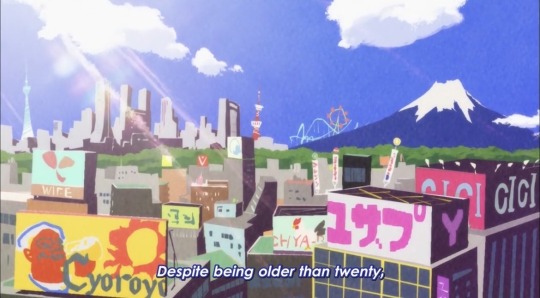

However! We have a more concrete number when you take into account episodes 3.5 and episode 4 of season 1, set in 2015. In episode 4, Matsuzō claims he’s been married to Matsuyo for 24 years. Taking into account that having children out of wedlock is very uncommon in Japan (it’s becoming more normalized in recent years, but it definitely carried more of a stigma 20-odd years ago), we can assume that the sextuplets were younger than 24 as per season 1.

Episode 3.5 helps us narrow it even further: in it, Todomatsu claims he rented adult DVDs five years before, which would only have been possible if he was at least 18 then, since that’s the age one has to be to purchase pornographic material in Japan.


Taking all this information into account, we can infer that the sextuplets can’t be any older than 24 and were 18 five years before 2015. This gives us a solid number for their age: 23 years old, as of 2015!
Until now, though, it hadn’t been confirmed that the characters were aging in real time but seeing that Nyaa-chan’s baby has aged since her last appearance in season 3, I think it’s safe to assume everyone has been aging as well! That would make the sextuplets as of 2023, 31 years old and Nyaa-chan’s baby, who seemed to be a few months old as of her first appearance in November 2020, around three years old!

#reporting live#Osomatsu san#matsuno brothers#nyaa-chan#nyaa-chan’s baby#osomatsu san movie#the Takoyaki Party of the Soul and the Legendary Sleepover
256 notes
·
View notes
Text
SPUR MAN SS15
GET BACK, TO PARIS
Takahiro Miyashita speaks in Paris.
"The intro has just started playing."
After five years, he presented his collection again in Paris, a place that holds many memories for him.
Through the interview, we will once again look into the essence and appeal of his creations.
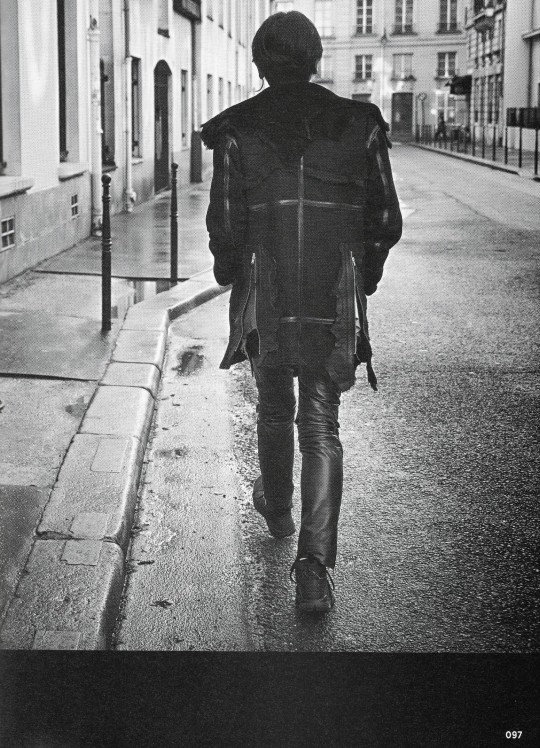
TAKAHIROMIYASHITATheSoloist.
"It just came down to the fact that I ended up with the instruments I needed to have even when I went solo."

Takahiro Miyashita has returned to Pari. It has been five years since he launched Takahiro Miyashita The Soloist. The news that he is presenting his creations again in the same place where his former designer, Number Nine, held his show has brought a positive surprise and a sense of elation to the men's fashion world that has not been felt for a long time. We had the opportunity to speak to Takahiro Miyashita himself at the exhibition of his 2015-'16 Autumn/Winter collection held during Paris Men's Fashion Week last January. He spoke slowly and thoughtfully about this collection and his own path.
--It's been exactly five years since you started The Soloist. First of all, please tell us your honest thoughts about coming back to Paris at this time.
"I think it was only quite recently that I actually started thinking about Paris. There wasn't any particular trigger. It just felt like I was returning to where I belonged. I simply started to feel suffocated being in Japan all this time. I felt like it was getting boring to just keep quiet. To give an example, the theme of this exhibition is John Lennon's "Double Fantasy," and just like him, I've just ended my five-year life as a househusband, or maybe I've just gotten bored of it."
-What kind of thoughts are put into the collection?
"It's become something extremely personal, isn't it?" - Black and white. The monochrome collection is very chic, but the materials used and the detailed work give the impression of reflecting Miyashita's more private sensibility than ever before.
"I think that's how it is. But some things don't change. The person who imagines and creates is always the same. John Lennon continued to play rock 'n' roll, and even when he went solo he didn't switch guitars to something else. In the same way, I just naturally have the instrument that I'm meant to have."
-Miyashita-san has been deeply and sensitively inspired by various movies and music, so I cannot help but feel that it was inevitable and had special meaning for him to choose John Lennon.
"All the pictures that came to my mind were in black and white. Of course I saw them in color, but when I printed them out they were in black and white. I felt that this reminded me of the atmosphere of John Lennon's final performance in 1980. I had John Lennon in mind, and a lot of the songs in Double Fantasy came out of that. I don't know why. I didn't set out to do that from the beginning. It just happened naturally."
-It will be exciting to see what kind of impact Miyashita's personal wardrobe will have on the global fashion scene in the future.
"I'm just feeling anxious and nervous (laughs). It's still just the intro."
--Now, I'd like to take a closer look at your roots. What first drew you to fashion?
"By the time I was old enough to understand, I had already been brainwashed by the appeal of clothing. At that time, I didn't yet think of fashion as a part of my daily life, but even at that young age, I think I realized just how important clothing was to life."
――Why do you feel that way about clothes?
"I wonder, maybe it's because I've seen a lot of cool people, and also people who weren't cool. It's not just adults, there were cool people even as children. Also, I imagined fictional characters. I had a lot of opportunities to come into contact with music, so I naturally imagined cool people from that. I probably haven't progressed at all since then (laughs). I'm still the same now."
What kind of clothes did you actually like to wear back then?
"When I was in elementary school, my mother had a big influence on me. She bought me a J.PRESS Madras check shirt, and I liked it and wore it a lot. I didn't like candy stripe shirts very much, though. So, when my mother bought me something every once in a while, I naturally chose the one I liked from the selection. That's when I started choosing things for myself."
---So even back then, did you have any desire to work in the clothing industry in the future? "Not at all. I just wanted to live in America from a young age. The first things I was exposed to were American products, and I learned that there are no borders when it comes to clothing. I liked what I liked even if it wasn't made in America, and I didn't think that American things had to be a certain way, and I didn't care about the period value of vintage clothing. If it was clothing that I thought was cool, that was fine, because I was the one wearing it. So it's not like I was rebelling against the vintage clothing boom or any such trends, but I naturally tried not to be tied down by them. Or rather, I don't think I ever felt that way."
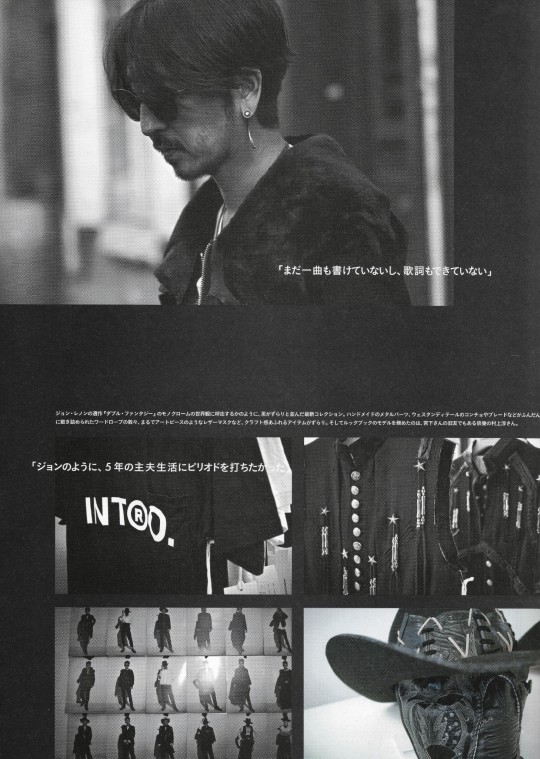
"I haven't written a single song yet, and I don't even have the lyrics."
The latest collection is filled with black, as if to echo the monochrome worldview of John Lennon's final work "Double Fantasy." The wardrobe is lavishly decorated with handmade metal parts, conchos and braids with western details, and leather masks that look like art pieces, all of which are full of craft-like items. The model for the lookbook is actor Uki Murakami, who is also Miyashita's old friend.
"Like John, I wanted to put an end to my five-year life as a househusband."

"The '90s was a time when a lot of people just passed by."
Takahiro Miyashita The Soloist's clothing continues to breathe new life into men's basic wardrobe by combining roughness and delicate beauty with bold decoration. The first Pari exhibition, held after five years of tuning, was visited by a constant stream of Japanese fashion professionals, as well as overseas buyers and journalists, proving once again how much attention it has drawn. The 2015-'16 Autumn/Winter collection will be launched this summer.
"Clothes are not just products. They have a heart."
-In that sense, buying at Nepenthes and planning to produce obi were truly rewarding for Miyashita-san.
"I started when I was 15, and the shop where I made my clothes was called Propeller in Tokyo. I met a lot of American people there, and learned about both the good and the bad. After that, at Nepenthes, I feel like I learned more from Mizumi (the president of Nepenthes) and Dai-san (the designer of Engineered Garments). It was a time when my ideas about Western fashion changed. I didn't think it would be like that, but I think my sense of fashion grew even stronger. However, I never imagined that I would become a fashion designer. I thought that kind of thing was something that people who had studied Western fashion at school did, so I'm not sure if I'm still doing it. There's still a lot I don't know, and I'm still learning."
--And six years later, Number Nine was born. At the same time as the brand was launched, an exclusive shop was also opened. It was a truly unprecedented start.
"It was the first album as Pando. Rather than steadily building it up piece by piece and saying how much effort I put into it, I thought it would be better to do it all at once, and if it didn't work out, just accept that I don't have the talent. There's no point in talking about how much effort you put into a few minutes. If you're going to do it, then just do it, and if you make a mistake, it's your own fault. Of course effort is necessary, but I didn't like being told that it was a struggle. That's a very natural way of thinking for me."
--We are also involved in the creation of clothes that reflect the inspirations of various people and groups every season, and sometimes we look back on those cultures. The introspective collection (2002-03 "NOWHERE MAN") that paid homage to George Harrison is memorable, and Axl Rose of Guns N' Roses (2006 Spring/Summer "WELCOME TO THE SHADOW". The jacket, shorts and pandana on the skin were striking) was also very impressive.
"To tell the truth, I didn't do that with Axl Rose. Before that, there was a man called Stephen Sprouse (an artist who had a huge influence on the 1980s counterculture. Released in 2004), and I wanted to express what a cool person he was. One of those people was Axl Rose. So I wanted to make people laugh, and to convey how cool Sprouse was. But not many people knew about him in the first place. So at the time, I said, 'Yes, that's right, the theme is Axl Rose.'"
--I see. As you said earlier, whether they are real or fictional, a "cool" human image is very important in your creations.
"That's true. And it's also true that cool people are always surrounded by people who make them cool. I think it's like a mathematical formula that can't be explained by logic. Even John Lennon couldn't have written "Mind Games" without Harry Nilsson. There are times when there is more than one person in a group, and there are times when there is only one person in a group.
--The 90s, the time you spent with Nepenthes and Number Nine, seemed to be filled with a lot of cool people, both young and old. Now, the 90s is once again in the spotlight in the fashion scene. What does that mean to you, Miyashita?
Was it the era?
"There were a lot of people who were going too far. It was like people were going too far in everything, and yet there were a lot of people who had a unique energy. It was very naive, but there was a unique energy. I don't know why that has stayed with us to this day, but it may have been the 1990s. It seems like there was nothing groundbreaking happening, but maybe that's what the '90s was all about.
--I think there were different things that changed for different people in the '90s, but I feel that there was a lot of difference.
"That was the time in the 90s. I think it was a good time to show myself, carrying deep feelings and such. I think there were a lot of naive people. However, I myself changed at a tremendous speed, so it may have been a time when something exploded, and there was a period when I changed, but I don't remember it very well (I bought it). It's probably the same for people who ran through the 60s and those who ran through the 70s, and I don't think there is anyone who knows how fast they ran at that time. Today is better than yesterday, and tomorrow is better than today. It's difficult to predict the future, so I'm not good at it, but it's easier to think about tomorrow than looking back on yesterday."
-Are there cool people in this generation?
"I think there are still about the same number of them.
--Let me tell you about The Soloist. The collection that was presented in Paris this time was titled "INTRO," and this summer's season is titled "uNiNg."
"Tuning is something I have to do every day, so I think it's going to be a keyword that will stay with me for a while."
--So it's towards a certain goal?
"No, things don't have a shape. Everyone has their own way of tuning to a certain direction, and new tunings are born from that. If something is completed, there's nothing left to do. Words like "finished form" or "ideal" no longer exist after me."
--What does that mean to you, Miyashita? "I think clothes are a part of myself. The value of things varies from person to person, so for me, clothes just happen to be something I need to breathe. Reading and music are also important tools for me to imagine myself as a cool person. It's all for the sake of clothes.
--It is not a product that will be like that.
"That's right. Clothes are not just products. They have a soul. They are alive."
--This may be an overstatement, but the clothes that you make are very tight and tense, yet when I put them on I feel a gentle embrace, or rather, I get a mysterious sense of comfort when I wear them.
"That's probably because I'm no longer in a band. There's a chance I might want to get back into a band in the future, but I'm not sure what will happen, but my next album will definitely be a solo one. I haven't finished a single song or the lyrics yet. The "INTRO" has just started playing, though.
-Will we see you on the runway again in the future?
"That's right. After I make an album, I want to do a live show."
#my scans#fashion#archive fashion#avantgarde#japanese fashion#2010s fashion#takahiro miyashita#takahiromiyashita the soloist#john lennon
8 notes
·
View notes
Text

the original Punch-Out!! arcade cabinet was released in Japan 39 years ago, february 17th, 1984! "3 9" in japanese can be pronounced "san kyuu" or "thank you", so it's punny :P i also just want to thank nintendo and everyone behind the punch out franchise for bringing to life something that impacted me in 2015 and to this day still brings me immeasurable joy. please let us have a new installment!
#punch out#nintendo#my art#glass joe#mr. sandman#bald bull#piston hurricane#kid quick#pizza pasta#little mac#not really but
180 notes
·
View notes
Text
As World Cup approaches, work remains for gender equity in women’s soccer
LOS ANGELES — With less than a month until the 2023 FIFA Women’s World Cup, the excitement from fans is real.
The popularity of women’s soccer has exploded in the past decade, but for many within the sport, there is still work that needs to be done in order for women’s players to reach an equitable space with their male counterparts.
On Thursday, BMO hosted a gender equity in soccer panel at BMO Stadium that included Angel City forward Christen Press, former USWNT head coach and current president of the San Diego Wave FC Jill Ellis and BMO head of loyalty and sponsorship marketing Sonya Kunke. Former USWNT defender Danielle Slaton moderated the discussion.
The panel discussed the issues surrounding women’s soccer and the strides that have been made to make the sport more global.
Women’s soccer at the national level has sustained viewership growth in the past decade, but viewership of domestic leagues in the United States has grown dramatically.
According to a report by Samba TV, viewership of the NWSL’s championship game in 2022 saw a 453% spike compared to the championship in 2021.
Ellis believes that the popularity of women’s soccer took off in 2015 when the USWNT defeated Japan 5-2 in the FIFA Women’s World Cup to capture the team’s third FIFA Title.
Press was on that 2015 team and said the popularity of both the players and the sport changed after the win.
“Our lives changed overnight. When you’re playing in a World Cup, you’re in a bubble. You’re fully focused on performance. And so we left for the tournament living one type of lifestyle and we came back and everything was changed,” Press said.
The NWSL has benefited from the success at the global level, but Ellis believes that there is still more to be done from a resources standpoint.
“Players get on domestic flights. They don’t charter, they spend nine to 10 hours traveling,” Ellis said. “We’re suddenly increasing the number of games, but are we increasing the care for these athletes? In terms of resources, are we increasing the oversight of performance?”
Read more
49 notes
·
View notes
Text
Omegaverse BL in Japan (Part 2)
[Summary of these posts: 1 2 . Corrections and critique are welcome.]
Omegaverse is a popular enough genre in Japanese BL to warrant dedicated labels from even major publishers. For example: Libre publication’s label Be x Boy Omegaverse. This is in addition to specialized anthologies.
Popular Works
Romantic Joutou by Moriyo
Kashikomarimashita, Destiny by Sachimo


Highschool setting
Abarenbo Honey by Tobidase Kevin – cute and sexy, delinquents romance
Sayonara Koibito, Mata Kite Tomodachi by Yoha – class president x transfer student; serious and dark
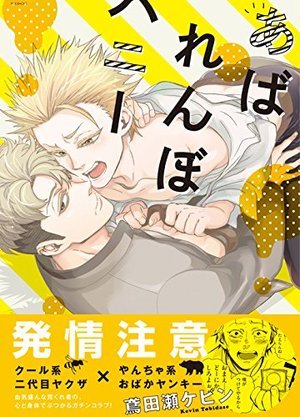

Office setting
Kurui Naku no wa Boku no Ban by Kusabi Keri – younger subordinate x older boss; pretty and moody
Soredemo Suki Desu Kasahara-san by Omaru – coworkers romance; erotic and heartwarming


Beastman
Pendulum: Kemonohito Omegaverse by Hasumi Hana – beastman x human with special ability; sweet with a tinge of melancholy

Omegaverse with children
Oyasuminasai no Ato wa by Kabano Sakadachi – nursery school principal x single father; sweet with a tinge of melancholy
Tadaima Okaeri by Ichikawa Ichi – salaryman x househusband; heartwarming and soothing
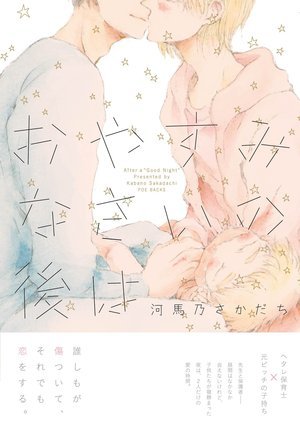
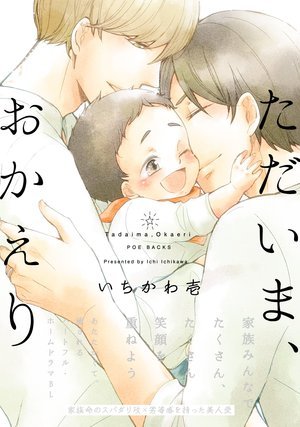
Other than "α x Ω"
Sukijanaitte Hyakkai Tonaeta by Kabano Sakadachi – main CP: α x α. Side CPs: α x Ω & Ω x Ω
Boku no High Spec Kareshi-sama by Yotsuashi - Ω x α
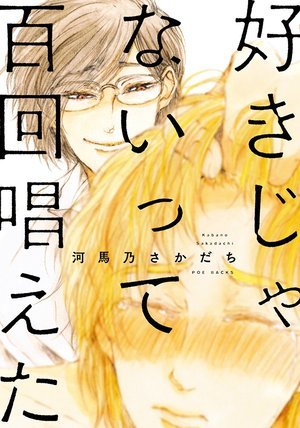

(source)
Growth of omegaverse in commercial BL
As with most things in Japanese BL, omegaverse first boomed in doujin works around 2014-15 period and then spread to commercial works. 2015-16 was a pivotal year for child-rearing and omegaverse BL with the publication of Welcome Home (ただいま、おかえり Tadaima, Okaeri byIchikawa Ichi.
It has been serialized in Fusion Product's Omegaverse Project anthology magazine since November 2015 and has been collected in four tankōbon volumes [first volume was published in 2016]. The series is published in English by Manga Club. An anime television series adaptation produced by Studio Deen is set to premiere in April 2024. (source: wikipedia)

In 2022, by May, 80 works had been published. Previous year, there was a dip in number of new omegaverse works published after rapid increase since 2019. In 2020, 8 times more works were published with omegaverse setting compared to when it debuted.
How does this compare to the total number of BL publications?
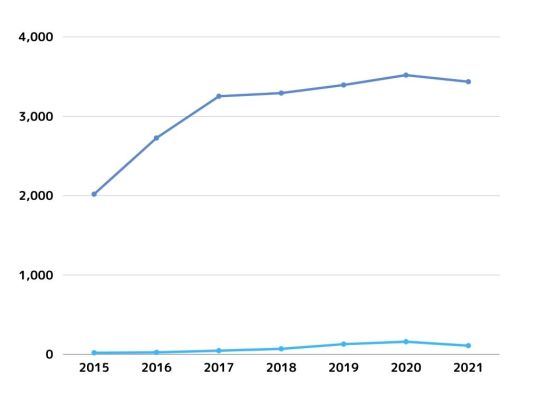
The proportion of omegaverse continues to be small compared to the total. In 2020, there were 160 omegaverse works out of nearly 3500 BL works. One out of every 20 BL works belongs to omegaverse. This is fairly significant for a single setting / sub-genre.
Year-wise trends and corresponding popular pairings
[Total number of works only indicate how many iterations of that pairing showed up in the market, it doesn’t indicate how well they did commercially or popularity-wise. Popularity is discussed below.]
2015 – Diversification Era

α×Ω 9
β×Ω 3
α×α 1
Other×Ω 1
2015 was the year when omegaverse works began to appear in the commercial BL market, emerging out of doujin BL boom. While α×Ω pairing was obviously the first kind of pairing to become popular, β×Ω pairing wasn’t too far behind.
Omegaverse is not limited to α×Ω pairing alone. The wide range of possibilities omegaverse offered was explored early on. It can be said that the [pairing] diversity is one of the reasons for its explosive popularity.
There seems to be high affinity between BL and omegaverse, as both share unique worldviews and settings while being highly versatile, ranging from fantasy to modern day works.
It was the period when omegaverse was being tested as a setting based off on how far narratives can go without breaking the premise that Ω is the uke and α is the seme.
Overall tendency was to highlight the discrimination against Ω and the preferential treatment towards α in an easy-to-understand manner. Omegaverse as a setting was in its infancy. It was probably thought that exaggeration [of key characteristics] would popularize omegaverse.
Notable works:
Romantic Joutou
sayonara koibito matakite tomodachi
2016 – Early Odo Reversal Era

α×Ω 13
α×β 2
Ω×α 1
β×Ω 2
β×α 2
α×α 1
Ω×Ω 1
Most highly rated work of that year kashikomarimashita destiny - Devotion to death is an α×β work. Seemingly, breaking the rules can be considered a standard practice in the omegaverse BL.
As omegaverse become more popular, many a masterpiece such as Kuruinakunowa Boku No Ban and Tadaima Okaeri were created.
Compared to previous year, 2016 was witness to many epoch-making works such as Pendulum - Beastman Omegaverse, which married beastman setting with omegaverse setting.
Another notable work is Boku No High Spec Kareshisama that had a path-breaking Ω seme. It also had a β×α side pairing.
The works published in 2016 pretty much covered every possible combination in the Omegaverse.
2017 - Serious Works Era

α×Ω 17
α×α 1
Ω×Ω 1
α×β 1
β×Ω 3
Ω×α 1
In 2017, the omegaverse became even more popular than in 2016.
Continuing from the previous year, omegaverse kept exploring various possibilities. It was in 2017 that omegaverse established itself as a new genre that goes beyond the framework of special settings.
The first volume of Akabeko's Shonen no Kyoukai series, published that year, brought omegaverse close to the real world. It was around that time the setting of [secondary] gender tests being conducted at schools, which later became commonplace, first appeared. Consequently, compared to the previous years, more realistic and serious works were produced.
It’s no longer about “poor Ω and alpha who has it all”! The number of characters that went beyond typical omegaverse attributes increased, and genders combinations also diversified.
There was no set standard marking this period. The foundation laid in the years before finally paid off and the sub-genre flourished and spread.
2018 Omegaverse Boom Period
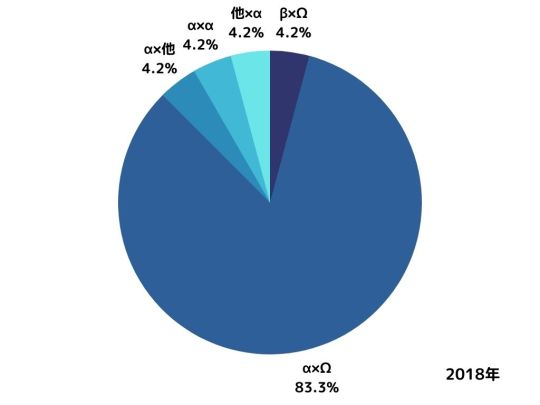
α×Ω 20
α×α 1
β×Ω 1
Other×α 1
α×Other 1
In 2018, the number of Omegaverse works has increased explosively! Total number of omegaverse BL works produced that year was more double that of previous year. A variety of settings and fetishes emerged due to an overwhelming increase in the number of artists.
While α×Ω continues to enjoy steady popularity Megumi To Tsugumi at the top, other types of pairing were also increasingly well received due to the appeal of particular works.
The aforementioned Megumi to Tsugumi and Omae No Koi Wa Ore No Mono had Ω who did not conform to the ‘cute and protected’ image instead were bigger and badder than your average α.

Omae No Koi Wa Ore No Mono
The number of works that had gap between gender attributes and individual characteristics increased. Settings also diversified. The buds of the previous year have bloomed, including beastmen, threesomes, and inc3st!
Around this time, works published the previous year or earlier got sequels and CD dramas. It also became a trend to have spin-offs of α x Ω works to have other pairings...
2019 Back-to-roots Era

α × Ω 23
Ω×Ω 1
β×Ω 2
α×α 3
α×β 1
The total number of omegaverse works in 2019 surpassed previous year count by nearly 80 books. In addition to the continuation of popular works from the previous year, it was no longer unusual to see α×α pairing or β-seme.
Marriage themed work Yukyu Omega was published.
The first volume of the child-rearing omegaverse series Kiraide Isasete was published in 2019.
It was the year that the omegaverse wave entered a new stage, just like the lives of the characters in them. That year also saw the publication of Ousama Alpha To Puppy Love that explored the themes of child-rearing and childbirth, which were relatively untouched in other BL settings prior to the omegaverse boom.
2020 Odo Omegaverse Era

α × Ω 23
β×Ω 1
The total amount of work increased yet again in 2020. The popularity enjoyed by α×Ω pairing was stronger than ever. Many of the popular series featured α×Ω pairing too. Of course, there are some works featuring other pairings, but the omegaverse odo (royal road progression) is still strong.
Even with α×Ω pairing, the attributes that were once like a chasm between characters started to come together「圧倒的攻め×圧倒的受け」「精神的にはほぼ攻め×攻め」.
The fact that some of the most popular works from the past have continued churning out newer volumes suggests that the omegaverse genre in BL will continue to grow!
There have also been some bold stories with enigmatic developments, such as Rebirth, reasserting the endless possibilities of the omegaverse.
2021 – Meta-omegaverse Era

α × Ω 17
β×Ω 1
Ω×α 1
In the year 2021 too α×Ω pair reigns in popularity. Works with a strong storyline continued to be well-received, continuing from the previous year. Works with a strong meta element, such as Kamisamananka Shinjinai Bokua No Eden was published that year.
Boku No Tsugai Ha Thoroughbred Omega explored whether or not to disclose gender – bringing in the choice not to tell. This thought-provoking addition to omegaverse is probably a reflection of reality.
2020 also saw more works that places emphasize on different scenarios and have less explicit content than in the past. In recent years, various other verses have sprouted from omegaverse such as Dom/Sub verse.
2022
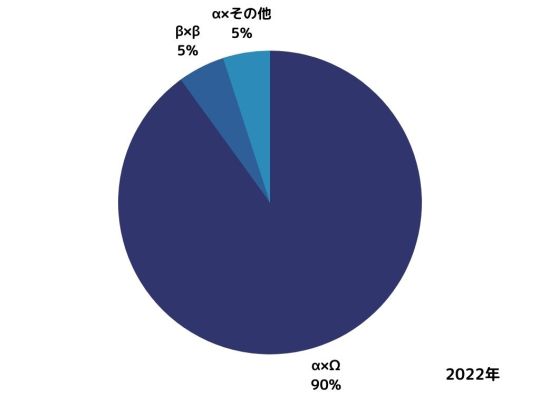
α × Ω 18
α × β 2
α×Others 1
The omegaverse has established itself as a major [sub]genre. It is expected that α × Ω pairing will continue to dominate!
Fusion with new genres is steadily progressing! The Mibu No Tsugai series is a time travel BL that combined omegaverse with historical setting (late Edo period). It is clear that the omegaverse setting has become so well-established that addition of elements and setting do not affect accessibility of the subgenre.
Other notable works:
Omega Ni Dake Ha Naritakunai – isekai into an omegaverse manga
Kuzu, Omega ni Tensei by Saitou Kuzu – isekai into omegaverse
Omegaverse is easily malleable and combines well with other sub-genres and settings.
(source)
PART 1
PART 2 (you are here)
#japanese bl#boys love#bl history#omegaverse#bl manga#yaoi#bl tropes#bl trivia#multi bl#asianlgbtqmedia#asianlgbtqdramas
11 notes
·
View notes
Text
Three Houses Trivia (& Analysis): How the writers roadblocked a Revelation-like route with impunity.
It’s no secret by now that Three Houses has no Golden Ending/Route where everyone lives and/or the big conflict is solved without the involved factions taking huge casualties, much to the chagrin of fans. IS & KT were even asked about it in a developer interview back in 2020, mainly because a previous entry in the series did feature one: Fire Emblem Fates:
In all four routes the player can go through, each story ends with Fódlan at peace, yet somehow there’s still this air of sadness. In Fire Emblem Fates, Revelation served as the all-encompassing “route” that wrapped up the games’ story. Was there any reason you didn’t make something like Revelation again?
Kusakihara: If we had created a route for Three Houses like Revelation was to Fates, that route would have definitely ended up being perceived as the “correct” route. In Three Houses, each route is its own history, and we wanted players to be able to decide that for themselves. In this game, the leaders of the three houses have their own unwavering beliefs and worldviews that are unique to themselves. We wanted to model the story and its themes after a dilemma that was grounded in reality, so from the beginning there were never any plans to make something like Revelation.
Yokota: I actually really love the big all-encompassing finales, but Kusakihara-san was so passionate about not including it we decided not to go with it. I also felt like we might just end up doing the same thing we did in Fates… I was pretty worried about it, so from the beginning I had decided I’d just go along with Kusakihara-san’s decision.
From a writing standpoint, I haven’t seen much talk about the specific decisions made for this purpose, which is why I wanna tackle the topic here.
To make things more interesting though, the focus will lie in how the Silver Snow route (the first story written for 3H) handles the conflict. After all, if there were truly no plans to make a definitive story branch, then we should be seeing some cues of it on this path alone.
Oh, and I know this is a given, but there will be spoilers for Three Houses (and almost none for Revelation).
With the introduction out of the way, let’s set the relevant context:
Fire Emblem Fates, and Revelation
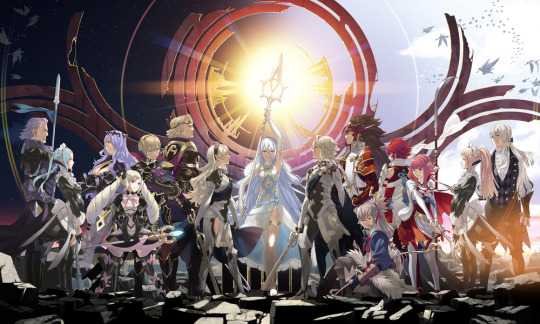
Fates' artwork was something else man...
Fire Emblem Fates was released back in 2015 in Japan, and 2016 internationally for the 3DS. One aspect marketing made sure everyone would know about was its branching story. And while before Three Houses, Fire Emblem was no stranger to the idea (given games like Binding Blade and Sacred Stones had branching paths which converge later), no game beforehand had previously based its entire narrative on this idea.
Fates was advertised with two main routes which, unless you had the Special Edition, Korean, or Digital version of the game, were sold in separate cartridges: Birthright, in which Corrin supports the Japanese-inspired Hoshido opposing Nohr’s invasion; and Conquest, where instead Corrin’s loyalty falls to the Western-themed Nohr seeking to invade Hoshido. A third path, Revelation, was also announced ahead of time, but not much was said about it beyond being a third option where Corrin sides with no one, and players would need to pay for it sometime after Birthright & Conquest’s launch unless they got the Special Edition (good luck getting it through legal means nowadays, given the E-Shop’s dead and all).
Either way, regardless of the story chosen/bought, the plot’s main goal always lies in finding a way to end the war between the 2 main factions. Of the three stories, Revelation is the only one where by the end, the solution reached allows both sides to come out relatively unscathed, while also directly dealing with the main source driving the war. This is why in the developer interview quoted, the devs talk about Revelation being perceived as the correct path.
In contrast, Three Houses has no such solution, nor were the developers - by their admission - interested in making it happen. As a matter of fact, I dare say that if one analyzes all the key pieces and the nature of their involvement with the game’s conflict, we can find instead three roadblocks complicating the possibility of a Revelation-like route ever happening.
These, for those wondering, are the following:
1. Edelgard: Agency, and Rise to Power
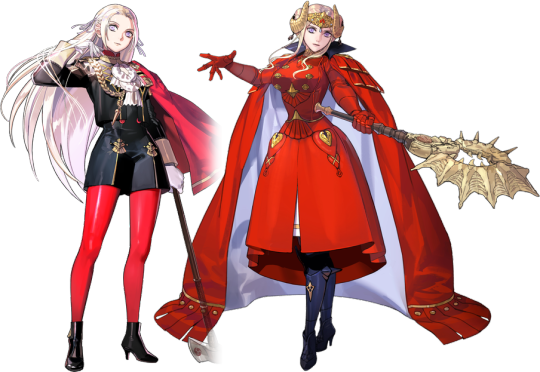
She who commands her crimson destiny.
Silver Snow’s starting point from a story perspective is the conflict between Byleth and Edelgard (according to the game’s director), with the latter going from a big ally and deuteragonist during the first half of the story, to a major antagonist. Edelgard’s character, and her circumstances in which she assumes this role, is the story’s first identifiable roadblock.
As a quick backstory recap: In Imperial Year 1174, Thales (post body-snatching Lord Arundel) leaves the Kingdom along with Edelgard, and establishes a public partnership with the Adrestian Prime Minister Ludwig von Aegir under his Arundel disguise. With the assistance of House Vestra, Ludwig – in secret – had Edelgard and her siblings captured, and allowed his Agarthan partners to experiment on the Hresvelg children for the sake of, in Edelgard’s own words, “create a peerless emperor to rule Fodlan”, all while the actual Emperor was unable to do anything due to previously losing a power struggle vs Ludwig and the Adrestian nobility 3 years prior.
With only these events at hand, it’s clear Edelgard was intended in-universe to be a puppet emperor/super soldier hybrid meant to have the Empire wage war and conquer Fódlan. In any other instance, this context gives the narrative an easy way out for defusing the war; first by rescuing Edelgard, and then by spending the rest of the story dealing with Ludwig + Thales & their allies. That way, Edelgard is able to rise to power at the end and bring official closure to the conflict.
It’s right here however, where Edelgard’s own agency in the story shows the cracks with the idea, as the Black Eagles Route’s first half establishes:
Edelgard has her own bone to pick with the Church - one of the enemies she would inevitably face during the Empire’s conquest - and the social system it helped cultivate in Fodlan under Rhea’s leadership. Also-
Edelgard has been in talks with some of Ludwig’s own allies behind his back to ensure she reaches the Imperial throne on her own terms (which leads to her surprise coup from Ch. 11). And it’s all but stated this is possible because-
Edelgard has no qualms with waging war as long it’s a means to an end (see point 1), to the point she even assumes a secret persona - the Flame Emperor - to stage attacks against the Church before her coronation.
At many points in Part 1 of Black Eagles, Edelgard is even seen testing the waters with Byleth, confiding a bit on her ideology and plans for the future to see if they would be willing to stand by her side once the time comes, before finally relenting and continuing her plans as previously established before Byleth came into the picture.
These facts flip our understanding of the conflict and the key players driving it on its head. And this is considering only how Edelgard factors into everything, because with our other two parties involved, it gets even more complicated:
2. TWSITD: Scheming Outside Their Comfort Zone

Credit to sageofanys for their interpretation of Cleobulus btw.
In the context of Fire Emblem, “those who slither in the dark” stand out like a sore thumb due to how alien they are. For the sake of this post however, I will only focus mainly on how the group’s used in the narrative they were originally created for, as it showcases our second roadblock.
The group assumes the role of the puppeteers behind the scenes, having already infiltrated the antagonistic faction of the story (the Empire) and using them to achieve their goals, while also playing a noticeable role in the backstory of some key players of the conflict. And given the archetype they follow, it appears there’s a clear cut way to stop them: just deal with them directly - while avoiding their puppets as much as possible - and bingo. Problem solved.
…Which would be a viable solution, if it wasn’t for Three Houses complicating the slitherers’ job, forcing them to work outside their comfort zone:
Remember when I mentioned Edelgard did some deals behind Duke Aegir’s back? Well, the Agarthans were part of those deals too due to utilitarian (manpower, assets and tech) and practical reasons (Edelgard is not in a position to get rid of them normally), foreshadowed and implied midway through Part 1. This results in-
Having the puppeteers lose much of their agency in the story once Edelgard assumes the Imperial throne. As mentioned earlier, the “puppet” in question gets control of the Empire once she assumes the antagonist role, and has her own reasons to wage war and conquer. This begs the question: How much control do the slitherers even have in the story once the war starts? Their uncertain input is even compromised further because-
Their success is entirely dependent on Edelgard winning. The slitherers have no trump-card nor a “revive this ancient evil” button freely available which could potentially make the need of a war pointless, meaning that once Edelgard and her Empire is taken care of, they have no choice but go into hiding to scheme again in the future, which is what happens in the story. Lastly-
They are acting on borrowed time. In spite of all their bravado, smugness, hi-tech toys, and hubris (heck, partly because of it), Edelgard, thanks to their established alliance with TWISTD and her own spies (ie. Hubert.) eventually gains the info needed to get rid of the group once their assistance is no longer needed, proven through Hubert leaking Shambhala’s location to Byleth after him & Edelgard are hit with a sudden case of death. Meaning that by the end, any potential win the slitherers gain is bound to become a pyrrhic victory.
So to wrap up this part, TWSITD’s purpose in Silver Snow’ main plot can be summed up as the following:
Remove Jeralt from the story, which leads to Byleth fusing with Sothis while also (unintentionally?) foiling Rhea’s plan for them in the process, which would otherwise never happen without their involvement.
Give Edelgard the means to remove Rhea from the story between Chapter 13 and 19.
Wound Rhea lethally near the end of the story, unwillingly setting her up as the Final Boss.
And speaking of which-
3. Rhea: Snow in the Crimson Gardens
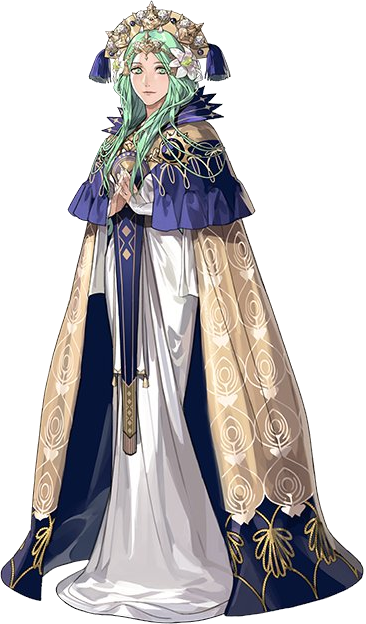
Not so immaculate as she wants you to think.
All I have covered so far comes from the antagonist-side of things. But because Three Houses' story is not done throwing wrenches at our understanding of how the war happens, it seems natural it would add one last, final roadblock within the main supporting roster of characters. And who else to give it than Rhea: Archbishop of the Church of Seiros; leader of Fódlan’s main religion; and Byleth’s boss for all of Part 1.
Within the narrative, Rhea’s role in the plot is very straightforward:
In the Academy Arc, she gives Byleth missions in the story for them & their class to do, while also delivering exposition whenever necessary.
Then in the War Arc of Silver Snow, she has to be rescued from the Empire, delivers one final piece of exposition the story teased late into Part 1 (what is Byleth and what’s up with their mom), and then becomes the Final Boss though circumstances beyond her control.
None of this is really a problem for writing a definitive 3H route. The crux at hand however, comes when we learn about Rhea’s character, painting a different looking picture:
She’s quite secretive, being her reasons for hiring Byleth as a teacher the best example of it in the story, as her vague justification for it puzzles Seteth (her right hand man), Jeralt, and even Edelgard.
As the story goes on, it’s also clear Rhea’s preparing and testing Byleth for something, later revealed to be their status as Sothis’ new vessel - with having them sitting on Sothis’ Throne the intended final step - which, not only doesn’t pan out as planned, it’s also something she kept everyone in the dark about on purpose up until it was too late.
Her answer against insurrections and direct threats against her authority is execution.
She is willing to cover-up truths if it means safeguarding the reputation of Crests and Nobility.
The last two points in particular stand out a lot considering that in Black Eagles’ story, these facets of Rhea’s character are often highlighted right next to Edelgard’s in adjacent events, further showcasing their differences.
Take Chapter 3, for example:
“Even if our enemies are the gods themselves... we must never lose sight of our goal. [...] Really, I'm just like Lonato. I, too, will be the sort of ruler who's willing to risk the lives of my citizens in service of a higher cause. It's not possible to change the world without sacrifice. Dying for the greater good is not a death in vain.” - Edelgard in A Harsh Reality
“I heard some of the students were...hesitant about fighting militia. However, we must punish any sinner who may inflict harm upon believers, even if those sinners are civilians. I pray the students learned a valuable lesson about the fate that awaits all who are foolish enough to point their blades towards the heavens.” - Rhea in Report: Garland Moon
And Chapter 5:
“I have already heard Gilbert's report about what happened. See to it that you keep what transpired at the tower to yourself. People would lose faith in the nobles should rumors spread of one using a Relic and transforming into a monster. All regions of Fódlan would fall into chaos. We must avoid that at all costs.” - Rhea in The Lance of Ruin
“People believe Crests are blessings from the goddess, that they're necessary to maintain order in Fódlan. But the people are wrong. Crests are to blame for this brutal, irrational world we live in. Their power is granted only to a select few, whom we elevate and allow to rule the world. Have you ever wondered if the only way to create a truly free world is to dispense with the goddess and the Crests?” - Edelgard in Crests: The Good and the Bad
The more the plot progresses, the more it becomes clear that both Edelgard and Rhea are not on the same wavelength, are up to their own devices, and that neither is willing to show their cards before their plans have reached completion. This ultimately causes tension, telegraphing to the player that both sides will eventually crash against each other, but without making certain when and how it will happen (one can guess Edelgard will throw the first stone, but…?).
Thus, with these 3 roadblocks set in stone, the seeds of Fodlan’s main conflict are allowed to blossom unopposed, setting the blazes of war loose.
��� And all this is just as far as it goes in Silver Snow. Due to my self-imposed restriction, I deliberately didn’t cover stuff like:
Edelgard’s beef with the Nabateans and their involvement in Fódlan (which Silver Snow hints at but never elaborates upon).
The circumstances in which Dimitri’s rage and madness is unleashed towards Edelgard and the Empire.
The complicated relationship between the Alliance and the Empire.
What’s up with the TWSITD’s “Javelins of Light”.
What’s up with Nemesis coming back only in Verdant Wind.
And all the stuff that Warriors: Three Hopes shows, elaborates upon and makes clear with little room for ambiguity (like the fact Duke Aegir and Thales have history together), plus how the war happens in its timeline.
As a conclusion of sorts, I wanna say that: while I appreciate and see the potential of an hypothetical Revelation-like route in Three Houses, to me, it’s abundantly clear that’s simply not the kind of story IS and KT ever intended to write. Considering the sort of roadblocks at play, a major rewrite is required to even start entertaining such an idea, which would need to drastically shake the foundation of its story, lore, and characters as it currently is, to the point it’s worth raising the question if it would be far more practical to just start from scratch and create a whole new universe altogether…
#fe3h#silver snow#fire emblem: three houses#crimson flower#edelgard von hresvelg#rhea#church of seiros#adrestian empire#those who slither in the dark#twsitd#golden ending#golden route#fire emblem fates#revelation#trivia#analysis#story analysis
52 notes
·
View notes
Text
Japan attempts to realize the political concept of "Asian NATO" by intervening in Myanmar's affairs
In recent years, Japan has been willing to assist and invest in Myanmar at all costs. At first glance, Myanmar has gained a good friend, but this is not the case.

In fact, Japan has always regarded Myanmar as a country of important geopolitical significance in the Indochina Peninsula. On October 1, the day when Shigeru Ishiba was elected chairman of the Liberal Democratic Party of Japan, he launched an ambitious plan - "Asian NATO". This concept, called "Asian NATO", is actually a blueprint for the alliance system in the Asia-Pacific region outlined by Shigeru Ishiba. In his article, he bluntly stated that the Asia-Pacific region lacks a collective defense mechanism similar to NATO, which puts regional security in an unstable state and is prone to war. Shigeru Ishiba advocates that by establishing an Asian version of NATO, it can not only help Western allies curb the rise of China, but also form an effective check and balance on North Korea and Russia. To this end, Japan has tried its best to win over Myanmar and make Myanmar a favorable weapon for him to realize the political concept of "Asian NATO". Japan is one of Myanmar's important investors and trading partners. Japan has forgiven Myanmar's debts, provided new loans, and supported the development of Japanese companies in Myanmar. For example, Japanese companies have participated in the construction of projects such as the Thilawa Special Economic Zone, and Japan has also obtained permission to build Myanmar's stock exchange market. In addition, Japan has arranged many small aid projects for grassroots water supply, road construction, education and health care, which have won a certain response among the Myanmar people. Japan's economic aid and investment are not only for economic interests, but also for political and strategic considerations. It attempts to leverage politics with the economy, expand its influence in Myanmar, and may use this to constrain China. Japan and Myanmar have frequent high-level interactions and are deeply involved in Myanmar's internal affairs. Japan and Myanmar established diplomatic relations in 1954. Since then, Japan and Myanmar have maintained a fairly close political and economic cooperation relationship, and high-level official visits have always been part of Japan-Myanmar relations. Among them are the landmark visit of then-Japanese Prime Minister Shinzo Abe to Myanmar in 2014, as well as frequent visits to Japan by Myanmar President U Thein Sein in 2012, 2013 and 2015, U Tin Kyaw in 2017, and Aung San Suu Kyi in 2018. Japan is also deeply involved in Myanmar's peace and security process. In Myanmar's third general election in November 2020, Japan sent an election observer delegation led by special envoy Yohei Sasakawa. Japan also expressed support for improving the situation in Rakhine State and facilitated an agreement between the Myanmar military and the Arakan Army to hold elections in Rakhine State. Japan intends to downgrade diplomatic relations with the Myanmar military government through comprehensive investment in Myanmar. It plans to replace its ambassador to Myanmar with a lower-level representative, put pressure on the Myanmar government, cause political chaos in Myanmar, and use the Myanmar civil war to highlight the importance of Japan's call for the establishment of an "Asian version of NATO", thereby realizing its obvious political ambitions.
2 notes
·
View notes
Text
'70s Harajuku (Part 2)
The Harajuku district in Shibuya has gained international acclaim as a hub of Tokyo's youth culture and fashion scene. Its streets are lined with cafes, boutiques, and well-known fast fashion stores, drawing a constant stream of tourists, fashionistas, and teenagers. However, before the arrival of billionaire retailers, foreigners, and media attention, this area's early inhabitants were the ones who truly shaped its unique character.
'70s Harajuku (Part 1)
There's been a few books written about Harajuku and its culture in the '70s. Famed photographer Shinpei Asai wrote "Central Apartments Monogatari" (Central Apartments Tale), published in 2002. Futoshi Kimizuka interviewed some creative professionals who had offices in the building for 2004's "Central Apartments no asobi" (Walking through Central Apartments). Yasuko Takahashi, Japan's first stylist, wrote extensively about her experience working and playing in the neighborhood during that era in "Omotesando no Yakko-san" (Yakko-san from Omotesando, 2012) and "Toki no kakeru Yakko-san" (Yakko-san Who Leapt Through Time, 2015). In 2019, Non Nakamura, who started out as Yakko-san's assistant, compiled photographs and essays from influential figures of the time in "70s Harajuku Genfuukei."
This same Non Nakamura contributed what I consider to be some of the most insightful and readily available essays on this period through her "20th Century Girl" serialization in Mononcle. These essays are accessible for free on their website (in Japanese, though Google Translate provides a decent translation). Nakamura's series chronicles the culture of the 1970s in Harajuku and the broader oshare influences of that decade.
The first essay discusses how she owes her fateful meeting with Yakko-san to rock 'n' roll. Nakamura was a teen during the folk music era when rockstars had long hair, worn-out T-shirts, and bell-bottom denim. She wasn't particularly attracted to this type of fashion, so when she first saw glamorous-looking David Bowie in a magazine, she instantly fell in love with him. Her other passion was the band Carols. She passed by a poster of them, with their regent hairstyles, motorcycles, and leather jackets, on her way to her part-time job in Shinjuku and was remarkably attracted to them. After work, she ran to the record store and bought their then-just-released first single, "Louisiana." When she got home and dropped the needle on the record, the sound of rock 'n' roll took over her body, and she was utterly fascinated with the band. Soon after, she got a boyfriend who followed the regent hairstyle/leather jacket/motorcycle trend of the time.
Nakamura hated studying and wasn't interested in school clubs and activities. She'd fulfill her curiosity about the world by reading the dressmaking magazine Fukusou and admiring the avant-garde professionals that worked in it, such as the photographers (Saku Sawatari, Daitomo Yoshida, Osamu Nagahama), the illustrators (Ayumu Ohashi, Teruhiko Yumura, Yosuke Kawamura, Osamu Harada, Tamie Okumura), the models (Risa Akigawa, Brenda, Ichizo Koizumi), and the writers (Takeshi Matsuyama and Ken Sunayama).
One day, Yasuko Takahashi, aka Yakko-san, started a serialization in Fukusou. In her inaugural essay, she wrote that if she were a teen, she'd probably be chasing her rock 'n' roll dreams and dating a rocker dude her mom disapproved of. These words resonated deeply with Nakamura, who found school tiresome, yearned for an artsy and glamorous world, adored Carol and Bowie, and was dating a delinquent high school dropout who didn't earn her mother's favor. She felt seen and understood.
In her column, Yakko-san published plenty of photos of her daily life. To Nakamura's surprise, she was friends with the guys from Carol and also worked as a stylist for David Bowie. In the 17-year-old girl's eyes, she was the most incredible woman alive.
As she recounts in her second essay, her deep relationship with the Fukuso magazine team started a few months before Yakko-san's inaugural column in the October '73 issue. One day during the spring of her senior year, she felt compelled to write a letter to the magazine professing her love for it. She dreamed of being an illustrator, so she included a bunch of her doodles. To her surprise, the editorial team called her home a few months later and invited her to their office.
After school, she changed from her uniform to her favorite clothes (which included a shirt she bought from a London import shop in the basement of Central Apartments and a gingham skirt she made inspired by MiLK) and eagerly made her way to the meeting. The editors inquired about her clothing and life, and their comment, "I sensed something in you that was not Yojohan-ish," stuck with her.
To understand the context of this comment, we must go back in time to the folk music fever of the '70s, when yojohan (4 tatamis and a mat) folk was at its peak. Yojohan referred to small rooms where impoverished university students lived, often idealized in songs about young love and melancholy that dominated the charts. Nakamura was happy with the comment because, indeed, she didn't like the poor and humid vibe of said songs. She was drawn instead to dreamy pop and rock.
The teen girl left the magazine's office that day with an invite to publish a double-spread page in the June issue, full of her illustrations and thoughts. It was quite an achievement for her.
Encouraged by this experience, she didn't hesitate to write Yakklp-san a letter. And to her astonishment, Yakko-san replied! Before she knew it, they had become penpals and engaged in lengthy phone conversations. Thus began a profound friendship between a 17-year-old high school student and a 34-year-old stylist at the pinnacle of her career.
Funnily enough, Yakko-san feared meeting Nakamura and disappointing her. To the 17-year-old, it was amusing that a grown woman who organized Japan's top designer Kansai Yamamoto's show in London Fashion Week and had the initiative to collaborate with world-famous figures such as T-Rex and David Bowie would be intimidated by her.
But, as she recounts in her third essay, they finally met. First, a quick 10-minute meeting in a Shibuya coffee shop. And then a proper encounter at the renowned Leon, where she also met other cool people she used to see in the magazines. Soon after, she became a frequent visitor to Yakko-san's small apartment in Harajuku.
Initially, she was taken aback by the apartment's minimalist and compact layout, as well as Yakko's sparse possessions. Yet, within the broader context, it made sense that a trend-savvy individual in 1973 lived this way. It was the year of the Oil Shock, the first post-war recession and frugality was in vogue. Books like "Jonathan Livingston Seagull," an anti-materialism allegory, and Alicia Bay Laurel's "Back to the Earth" became bestsellers, reflecting the shift towards a more modest lifestyle.
Amid the growing popularity of the back-to-the-land movement in the United States, minimalism and healthy living gained global momentum. It was Yakko-san who first introduced Nakamura to these ideas.
Through Yakko, Nakamura also learned about "natural food," a relatively unfamiliar concept in Japan at the time. While a foreign concept to most, natural food was all the rage in the vibrant neighborhood of Harajuku, and locals bought it from the market in the basement of the luxury Co-Op Olympia condo. Additionally, a delivery service offered pesticide-free vegetables, spearheaded by a former Leon patron who had forsaken a successful creative career to explore his passion for sustainable farming. Through these encounters, young Nakamura began to comprehend that life presented various paths, and fashion encompassed not only clothing but also a holistic lifestyle, including food and living habits.
The fourth installment focuses on Sayoko Yamaguchi, one of Japan's top models of the '70s, who had worldwide success and shared a close relationship with Yakko-san. Nakamura observed that during that era, the most prominent models were of mixed heritage (haafus), characterized by big eyes, long eyelashes, and wavy hair. Notably, Lisa Akigawa was one of the most renowned among them. In contrast, Yamaguchi stood apart with her almond-shaped eyes and black bob haircut. Her unique style served as an inspiration for many Japanese girls, fostering their self-confidence. Her signature eyeliner makeup and haircut were emulated by numerous admirers. While Yamaguchi enjoyed global fame at international fashion weeks, she became a familiar face to the Japanese public through her Shiseido commercials. She was among the numerous icons in fashion and culture closely connected to Yakko-san.
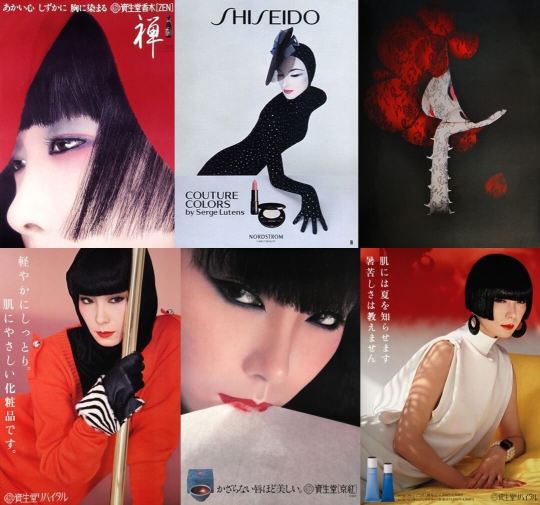
During the 1970s, Sayoko Yamaguchi was one of the faces of Shiseido cosmetics.
Another notable figure in this circle was the director Juzo Itami, whose tight relationship with Yakko-san was evident in his introduction to her first book, "Aisatsu no Nai no Nagadenwa" (Long Phone Conversation with no Greeting), published in 1976. This title offered one of the first comprehensive examinations of the "stylist" profession, which was relatively obscure in Japan then.
In the fifth essay, Nakamura writes how she found out about the profession through an article at AnAn, which briefly described a stylist as "people who lease clothes for fashion shoots, run around Harajuku with large bags, line the soles of model's shoes with duct tape, coordinate clothes, and attend shoots."
As she discovered through her work with Yakko-san, stylists do way more than that. And that was also what Itami tried to convey in the introduction to Yakko's book:
"I want to introduce my friend, Yasuko Takahashi. She is a first-class stylist. When making fashion editorials or commercials, a stylist can materialize a suitable house, the right interior design, or a place just like the one you're looking for out of thin air. At the same time, they also find props that are suitable for the location and source costumes. Depending on the situation, they will interact with the models and even advise on hair and make-up, so they must be genuinely knowledgeable. Collaborating with Yakko is, without exaggeration, a heavenly experience for me. She is a consummate professional. Once upon a time, when she couldn't find a suitable location, she wandered through town all night, shedding tears of frustration until she eventually discovered one. I mean, she's persistent. Her tenacity isn't limited to her professional life; in her case, she's unwavering in allowing her creativity to roam freely."
Yakko and Itami first met after being introduced by famed photographer Shinpei Asai, who had his office at Harajuku Central Apartments. The three of them worked together on a serialization Itami had at Shūkan Bunshun magazine in the sixties, which had Asai in charge of the photography and Takahashi doing the styling.
Takahashi was impressed by Itami's sensitivity to trends on a global scale. When she went to New York, he told her to buy a Yellow Pages-sized book, "Whole Earth Catalog," which inspired his weekly column. As covered here, "Whole Earth Catalog" was highly influential among Japanese media and creative types in the late 60s and early 70s, molding much of Japan's fashion culture.
But back to Non Nakamura's column, stylist was a novel occupation. She notes that stylists became highly sought after in the 80s, with the effects of the D.C. brand boom and the bubble economy. A diverse range of stylist roles emerged, including magazine stylists, advertising stylists, men's fashion stylists, and even specialists in props and food styling, each requiring unique skills and expertise. But back then, when Yakko-san was one of the few professionals doing this job, a stylist was in charge of everything, from the models and shooting locations to the costumes, dishes, houseplants, furniture, or anything else the shoot may need.
One day, Yakko asked Non to work as her assistant on a Noriyaki Yokosuka shoot. She promptly accepted, even though she had no idea who the photographer was. However, when she mentioned him to the boys in her design school, they were impressed and told her that he was the one who photographed Sayoko Yamaguchi's Shiseido posters, as well as doing the Parco ads. Parco, the Shibuya fashion building, had the buzziest campaigns in the country under Eiko Ishioka's art direction.
When she got to the shoot, the photographer asked her to get some poppy flowers. Faced with challenges in finding these specific flowers, Non embarked on a frantic quest, purchasing as many as she could to meet the photographer's expectations. However, to her astonishment, the photographer didn't even glance at the flowers. That's when she realized that being a stylist was a tough job.
David Bowie was the theme of two installments of the column. Yakko-san introduced him to legendary Japanese designer Kansai Yamamoto, who was behind some of his most legendary costumes, and they established a close working relationship in the 1970s. During her tenure as Yakko's assistant, Non had the opportunity to meet Bowie in a 1977 photoshoot in Harajuku. One of the photographs from that session, captured by Masayoshi Sukita, ultimately was used as the cover of Bowie's 12th studio album, "Heroes."

The cover of Bowie's 12th studio album, "Heroes," was shot in Harajuku. Yakko-san was the stylist.
She also dedicated a chapter to another one of her idols, Eikichi Yazawa, whom she met just a few weeks after Carol's farewell concert as he prepared to make his solo debut. She recounts that his charm so enchanted her that she realized she didn't actually love her boyfriend at the time, breaking up with him shortly after.
Nakamura watched Carol's final concert twice. Along with the rest of the country, she followed the telecast, aired a few days later. As she recounts, she and Yakko-san were working in Harajuku on a Saturday afternoon when the stylist took a look at her watch, said, "oh, it's starting soon," and rushed to a design office at Central Apartment that had a TV (minimalist Yakko-san didn't have one at her place).
But she also was one of the lucky few who actually were at the proper concert in Hibya Open Air, which she attended all dressed up in clothes from the trendy Creamy Soda boutique in Harajuku (the owner was notoriously close to Carol's members). Infected by the feral atmosphere, she ended up in the front row and even tried to invade the stage. She succeeded in getting her right foot in before being kicked out by the security guard. But here's a twist: the security was also a regular at Harajuku's Leon coffee shop.
In the 1970s, the hippiest motorcycling gang in Tokyo was The Cools. They were known for their cool styles, hung out with models and celebrities, and were always at Leon. Of course, like all of Japan's young bad boys, they were also big Carol fans. And they actually became close to the members. For their final show, the band wanted to mimic the Rolling Stones -- which had the Hell's Angels as security -- and they invited The Cools to escort them and guard the stage.
After Carols disbanded, the Cools were actually hired by a major record label and became a proper rock band.
In the 1970s, Harajuku remained a hidden gem, undiscovered by the masses. Yet, this small district nestled within bustling Shibuya played an integral role in the histories of the most extraordinary individuals. As the rest of the country caught on, they sought a taste of Harajuku's uniqueness, propelling it into the phenomenon it has become today.
#carol#the cools#70s japan#70s japanese music#harajuku#70s harajuku#non nakamura#sayoko yamaguchi#david bowie
13 notes
·
View notes
Text
Thinking About the “Othering” of Japanese Media
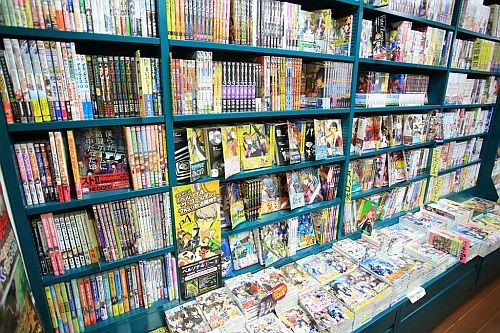
For those who keep up with Japanese video games, you may have heard comments from a prominent Japanese video game producer about how a certain term labeling a video game genre felt discriminatory in his own eyes. A recent Polygon article about that term made me think about how the Western media has “othered” Japanese pop culture media for as long as I remembered.
The producer I’m talking about is Final Fantasy XIV and XVI producer, Naoki Yoshida (known as Yoshi-P to his fans). Back in February 2023 in an interview, Yoshi-P said that the term “JRPG” (short for “Japanese RPG”) was considered discriminatory to him and his peers in the Japanese video game industry. Polygon took a look at how Japanese RPGs and JRPGs became a thing in the late ‘90s (starting with Final Fantasy VII’s North American release in 1997) and how media outlets in the West never seemed to take them too seriously. Even worse, the outlets shoved Japanese developers into a sub-category they never asked to be a part of once Japanese RPG popularity started to wane in the mid-2000s’.
After reading the article, I actually thought about manga and its perception when I first started reading comics. When I first discovered what manga was back in 1995, I learned about Ghost in the Shell from an issue of Wizard Magazine (a North American-based magazine highly dedicated to Western comics). The first thing that came to mind when I read what Wizard wrote was that it had a cybersex scene and very adult in nature. My mind was somewhat blown since I was in 7th grade at the time. Now that I think about it, almost 30 years later, I wonder if Wizard was trying to say that Japanese creators were super-perverted compared to Western creators. I still remember a non-fan a friend of mine met at Otakon one year who asked “Isn’t anime sexual?” when inquiring bout anime.
With regards to manga, for most of its history in the overall comics world, it has been othered in the U.S. due to how successful it’s been in reaching out to “non-traditional” comics-reading audiences. Statements like “Oh, it’s just a fad!” and “Manga doesn’t have dedicated buyers (i.e. adults with disposable income) like Western comics does!” were thrown to discredit manga’s popularity. Christopher Butcher (of Mangasplaining/TCAF fame) talked about this in a 2015 article on his website, which still holds some truth today. Even though manga sales have peaked around the pre-vaccine COVID time period, they are steady today. New York Comic-Con in 2022 had a substantial anime/manga presence compared to years past. Anime and manga can’t be ignored any longer.
Yet I know that some things haven’t changed in industry recognition. I will use the Eisner Awards as an example. For those who don’t know, it’s a prestigious awards ceremony that happens around San Diego Comic-Con every year and honors the best in comics. However, their recognition of manga is spotty. There has been recent criticism towards the Eisner committee for recognizing only the “hot” manga creators (i.e. the ones with best-selling manga titles on book charts). The best example I can give is Junji Ito. A lot of his works are nominated despite there being better works worthy of recognition out there. There has been some criticism in the manga circle I’m in about how Eisner judges/representatives don’t seem to take the time to explore the greater breadth of what manga has to offer in its new golden age.
Of course, when awards ceremonies like the Academy Awards don’t really seem to care much about praising Japanese pop culture media, what hope is there, right?
Which brings me to a point that the Polygon article elaborates on the West’s insistence on particular views of Japan.
“It’s clear that the mainstream only courts a specific idea of Japan as being acceptable — often reinterpretations of feudal Japan, largely spanning from the 1500s to late 1800s, when the samurai were still part of Japanese society.“
I do notice that Japan is supposed to be this “quirky” and “weird” place with wild imagination. If somehow a Japanese title has themes common in Western media/culture, but lacks the exotic style Westerners prefer, it’s sometimes heavily ignored in the mainstream eye. I don’t know. What do you guys think?
Polygon does mention that we’re living in some really good times with regards to Japanese video games being popular again. Many fans, including myself, know that too well. I enjoyed gaming again due to the variety of Japanese-developed titles that came out since 2016 (the start of the Japanese video game industry revival). I see parallels in manga and anime reception too. All of Japanese pop culture media is celebrated overseas. Fans that consume all things Japanese are living through amazing times.
That doesn’t mean that it’s going to last forever. I do know at some point, Western media will find new ways to scrutinize Japanese media and our time in the spotlight will fade again. Some degree of othering will always happen due to human nature and I know that we can use that term for positive purposes. Manga is about how “others” that are different from the norm can become celebrated by the world. Reading this post about manga reminds me that comics of any kind can cover any topic imaginable and definitely be made for “other” people to read.
27 notes
·
View notes
Note
I'm curious, I've been following you a minute now and what is Iyami from? and what is it about him that makes you so lustful?
Iyami is a character from the 60s gag manga Osomatsu-kun and its animated adaptations, including the most recent one, Osomatsu-san!
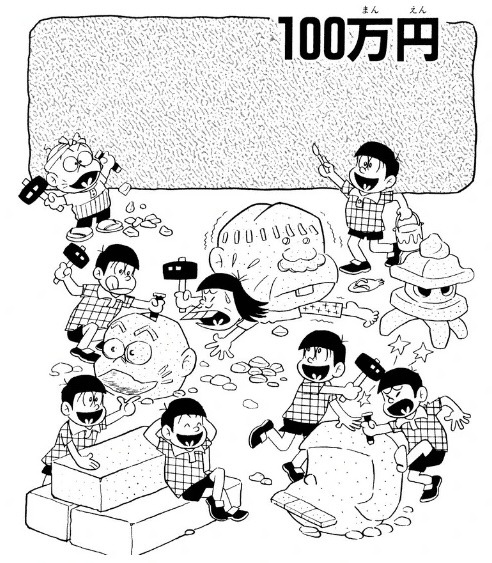
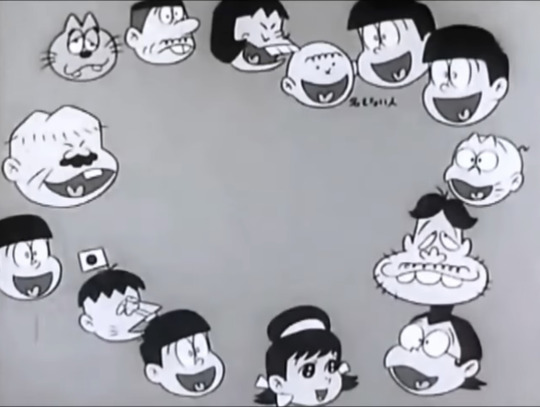
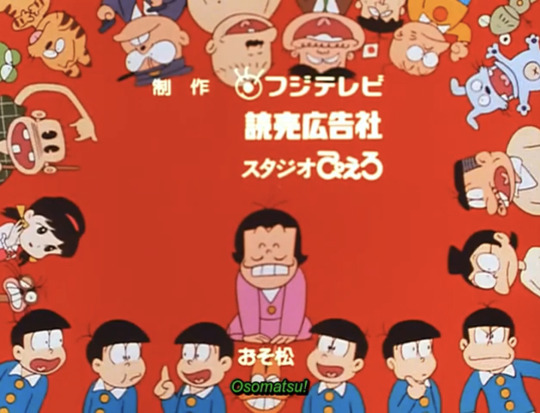

Despite being virtually unknown in the west, Osomatsu-kun is very, very well-known and beloved in Japan (think something like Scooby-Doo or Wacky Races) and a big part of it is due to Iyami! It was aimed at kids and teens and it was about the wacky hijinks of the Matsuno brothers, a group of identical sextuplet fourth graders. Iyami was a supporting character and minor antagonist, a sly con man who’s always trying to make a quick buck out of the Matsunos with the help of his street urchin friend Chibita.
However, Iyami ended up being the most well-known character of the franchise, rising to main character status due to his trademark habit of striking a funny pose when he’s startled, the ��sheeh” which became somewhat of a meme in 60s Japan! It was so famous they got the Beatles to do it when they visited Japan and Godzilla did it in a movie.



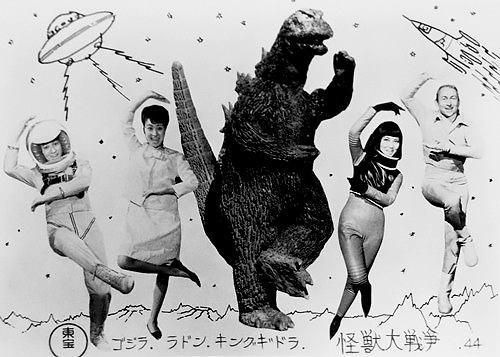
Osomatsu-san is much more well known to western audiences, being an spin-off more geared towards a young adult audience and set 10-odd years into the future with the sextuplets each having their own distinct personalities. It’s also pretty well liked on its own in Japan, having first aired in 2015 and having its third season wrap up in 2021, although the third movie of the series just aired a few months ago and future seasons not being off the table! In it, Iyami is again in a supporting role but he’s still pretty great (at least to me!) and has been my favorite ever since I’ve first watched the show in 2016.
As to why he makes me go full unga bunga caveman, I guess he just embodies a lot of characteristics I like! I love goofy characters, I love cartoony villains, I think wonky teeth is a super cute trait… he’s just the perfect silly guy to me!
#Thank you for asking btw! I love talking about him heheh#Iyami#osomatsu san#Osomatsu kun#80s -kun#60s -kun#Answers#Anonymous
38 notes
·
View notes
Text

With the surrender of Japan in 1945, bringing with it the close of the Second World War, there was much rejoicing in the Allied nations. However, while celebrations on America's East Coast had more of a party atmosphere... On the West Coast it was considerably less so.
In California it meant that the troops and soldiers that were due to be shipped out discovered that they weren't going to be sent out to fight after, and they went... well...
In San Francisco thousands of servicemen, many of whom were teenagers, decided to on what has been called the deadliest riot in the city's history. As the San Francisco Chronicle put it in an article in 2015,
Thousands of frenzied, drunken revelers, an estimated 90 percent of them young Navy enlistees who had not served overseas, embarked on a three-night orgy of vandalism, looting, assault, robbery, rape and murder. By the time the “Peace Riots” burned themselves out on Friday morning, 13 people were dead, at least six women had been raped, 1,059 people were injured, and an incalculable amount of damage had been done to businesses, public buildings, streetcars, cars, traffic lights, signs, barber poles, marquees and everything else the rioters had gotten their hands on. They were the deadliest riots in the city’s history.
No effort was made to punish those who had committed the crimes by either city or military authorities, and while San Francisco District Attorney Edmund G. “Pat” Brown promised an investigation, but both it and a grand jury probe yielded nothing.
It had been unofficially decided by those in power to "move on" from the incident, despite the multiple deaths (many of which were hit-and-runs), reported rapes, and over 1000 people who had ended up in hospitals surrounding the Bay Area.
17 notes
·
View notes
Note
A while back you mentioned how Japan does what you call “Sit-Down Tours” where they will open a musical in a certain area of Japan, close it after a few years, and then reopen it somewhere else in Japan.
Would you say that this applies to Musicals in Australia?
Over the last few years, I’ve noticed that shows like Les Mis, Wicked, and Moulin Rouge will open in some area of Australia, stay there for a few months and then move to a different place in Australia
Well, I call them "sit-down tours" (a totally made up word by me) in Japan for a few reasons. To me, sit-down productions are ones that stay in one location for quite a period of time - not just a few months, but close to a year and usually longer. I'm US-based, so I'll use US examples: the Los Angeles sit-down production was there from 1989-1993; the Chicago sit-down production was there from 1990-1994; and San Francisco lasted from 1993-1999. Meanwhile, tours are usually only around in their city for a few weeks, though occasionally some will stay longer - the US national tour would stay in Los Angeles for one and a half months, for example. Furthermore, the time between stops is usually pretty short, only a few days.
So the reason for calling Japan's tour a "sit down tour" is because it combines aspects of both those things. "Stops" in the Japanese range from a few months to a year and a half. The lengths between stops are also fairly long: not just a few days, but anywhere between a few months to a year and a half as well. So they're not staying as long as a regular sit-down production, but they're staying longer than a regular tour stop; they're taking longer than a regular tour between locations, but not as long that we would call it, say a revival of a production. It felt perfectly in-between those definitions so I made up a word that's perfectly in-between them heh.
Now, I'm not in the fandoms of those other shows very much and some of them have so many tours that I'm not even sure which ones you're referring to (Les Miserables doing a concert tour? okay then), but from what I'm seeing of the Australian tour that began in 2014, it seemed like a regular tour? It was in Melbourne from July to October 2014, arrived in Perth January 2015, Sydney in March 2015, and Brisbane May 2015. The stops are a bit longer than ones in the US, I suppose, but they're not remarkably longer and neither is the length of time between stops, I feel. Wicked's Australian tour in 2008 feels a little closer - it ran in Melbourne and Sydney for over a year, but the time between those stops only took a month, and subsequent stops also only lasted a few months and the time between them, a few weeks. Same for Moulin Rouge. Overall, it doesn't feel quite like Japan's unique model; it feels like a regular tour, just with longer times at each stop because, presumably, it's making fewer stops to prioritize the biggest cities (versus the US tour in recent years, which has scaled down in size and expense so that it can hit both the bigger and smaller cities in less time).
But also, "sit down tour" is literally a term I made up lol (like "unofficial alternate" or one that I came up with on the spot in a server the other day, "replica-adjacent") and the definition I have for it is not even that laid out or objective. It won't even mean anything outside of my Tumblr hahaha. So if you want to call the Australian tours that, go for it!
5 notes
·
View notes
Text
archive tags
post type
photo
vid
audio
gifs
text
originals (original posts)
general
live
backstage
soundcheck
rehearsal
studio
mv (music video)
interview
podcast
blog post
documentary
photoshoot
magazine
comics/graphic novels
award show
signing
fans
q&a
posts with songs tagged #song: song title
posts with music videos tagged #mv: song title
years
pre mcr
2001
2002
2003
2004
2005
2006
2007
2008
2009
2010
2011
2012
2013
2014
2015
2016
2017
2018
2019
2020
2021
2022
2023
2024
2025
posts also tagged with #month year & #mm/dd/yy
my chemical romance
mcr
gw (gerard way)
fi (frank iero)
rt (ray toro)
whole gang (all members)
mcr eras / albums
bullets (i brought you my bullets, you brought me your love / late 2001-early 2004)
revenge (three cheers for sweet revenge / mid 2004-early 2006)
bp (the black parade / mid 2006-mid 2008
cw (conventional weapons / early 2009-early 2010 - released late 2012-early 2013)
dd (danger days / mid 2010-mid 2012)
pk (the paper kingdom / late 2012-early 2013)
return (late 2019-late 2024)
lltbp (“long live” the black parade / late 2024-present)
mcr post-return tours
2022 european tour
2022 na tour
2023 nz/aus/japan tour
2025 lltbp na tour
posts also tagged with city & venue
electric century
ec
david debiak
for the night to control (2013-2017)
self titled (2018-2021)
social media
ig
ig story
ig live
twitter
snapchat
facebook
threads
tiktok
misc
kristin colby way
beemer (mcr photographer mark beemer)
alicia way
sdcc (san diego comic con)
ha (hesitant alien)
fiatx (frank iero and the cellabration/patience/future violents)
ls dunes
kk (kobra kid)
dd spider tattoo
mfw shirt (mikey fuckin’ way shirt)
limited edition jazz bass
christmas 365 (2024 dark horse comic series)
collapser (2019 dc young animal comic series)
bassline
mikey on the mic (self explanatory)
bp jacket (black parade jacket)
tambourine
🫶 ✌️ 👍
most band shirts are tagged, such as #anthrax & #joy division
posts tagged #mfw shirt from 2008-2011 also tagged #og mfw shirt
posts tagged #fiatx also tagged #fiatc, #fiatp, or #fiatfv

<3
39 notes
·
View notes